
Want to create or adapt books like this? Learn more about how Pressbooks supports open publishing practices.
Learning Objectives
- Determine the purpose and structure of cause and effect in writing
- Understand how to write a cause and effect essay

The Purpose of Cause and Effect in Writing
It is often considered human nature to ask “why?” and “how?” We may want to know how our child got sick so we can better prevent it from happening in the future, or why our colleague received a pay raise because we want one as well. We want to know how much money we will save over the long term if we buy a hybrid car. These examples identify only a few of the relationships we think about in our lives, but each shows the importance of understanding cause and effect.
A cause is something that produces an event or condition; an effect is what results from an event or condition. The purpose of the cause and effect essay is to determine how various phenomena relate in terms of origins and results. Sometimes the connection between cause and effect is clear, but often determining the exact relationship between the two is very difficult. For example, the following effects of a cold may be easily identifiable: a sore throat, runny nose, and a cough. But determining the cause of the sickness can be far more difficult. A number of causes are possible, and to complicate matters, these possible causes could have combined to cause the sickness. That is, more than one cause may be responsible for any given effect. Therefore, cause and effect discussions are often complicated and frequently lead to debates and arguments.
The Structure of a Cause and Effect Essay
The cause and effect essay opens with a general introduction to the topic, which then leads to a thesis that states the main cause, main effect, or various causes and effects of a condition or event.
The cause and effect essay can be organized in one of the following two primary ways:
- Start with the cause and then talk about the effects.
- Start with the effect and then talk about the causes.
For example, if your essay is on childhood obesity, you could start by talking about the effect of childhood obesity and then discuss the cause, or you could start the same essay by talking about the cause of childhood obesity and then move to the effect. Regardless of which structure you choose, be sure to explain each element of the essay completely. Explaining complex relationships requires the full use of evidence, such as scientific studies, expert testimony, statistics, and anecdotes.
Because cause and effect essays determine how phenomena are linked, they make frequent use of words and phrases that denote such linkage. See below Phrases of Causation for examples of such terms.
Phrases of Causation
- as a result
- consequently
The conclusion should wrap up the discussion and reinforce the thesis, leaving the reader with a clear understanding of the relationship that was analyzed.
Self-Practice Exercise 4.8
H5P: Cause and Effect Writing Practice
Exercise Preamble
In this exercise, we will think through the steps of a cause and effect essay. This can be tricky. We’ll start by choosing a topic. You want to pick something you know enough about to make claims about the relationships between cause and effect. For this in-class exercise, there’s no need to do external research, but remember that in a more formal assignment, you’ll want to have good sources for all your claims and to avoid speculation.
Some areas where cause and effect thinking is common include:
- Health and nutrition
For example, you might write a cause and effect essay about whether violent video games cause children to act out, or whether universal basic income programs cause people to live more stable lives. Choose something you can argue from a position of confidence.
Set a timer and freewrite for five minutes about the topic you have chosen.
Can you identify a potential thesis statement from your freewriting? Remember: The cause and effect essay opens with a general introduction to the topic, which then leads to a thesis that states the main cause, main effect, or various causes and effects of a condition or event. In other words, you don’t need to claim the only cause or effect — we know that ideas are complex.
Organizing Your Draft
Which makes the most sense for what you are trying to argue in your thesis statement?
Using point form, sketch out the structure of your essay: how many paragraphs, what will each one focus on, and how will you support it?
Writing a Cause and Effect Essay
Choose an event or condition that you think has an interesting cause and effect relationship. Introduce your topic in an engaging way. End your introduction with a thesis that states the main cause, the main effect, or both.
Organize your essay by starting with either the cause then effect structure, or the effect then cause structure. Within each section, you should clearly explain and support the causes and effects using a full range of evidence. If you are writing about multiple causes or multiple effects, you may choose to sequence either in order of importance. In other words, order the causes from least to most important (or vice versa), or order the effects from least important to most important (or vice versa).
Use the phrases of causation when trying to forge connections between various events or conditions. This will help organize your ideas and orient the reader. End your essay with a conclusion that summarizes your main points and reinforces your thesis. See Appendix 1: Readings: Examples of Essays to read a sample cause and effect essay.
Key Takeaways
- The purpose of the cause and effect essay is to determine how various phenomena are related.
- The thesis states what the writer sees as the main cause, main effect, or various causes and effects of a condition or event.
- The cause and effect essay can be organized in one of these two primary ways:
- Start with the cause and then talk about the effect.
- Start with the effect and then talk about the cause.
- Strong evidence is particularly important in the cause and effect essay due to the complexity of determining connections between phenomena.
- Phrases of causation are helpful to signal links between various elements in the essay.
Essay 1: Expository essay (15%)
In week 7, you will need to submit an expository essay on one of the following topics. Consider these topics as you work through the rest of this chapter and the next. You will need to choose one topic from one of the rhetorical modes below and write a 750- to 900-word essay. You will need to produce a logically organized essay with a thesis statement, well developed and logically organized paragraphs (with topic sentences), and an introduction and conclusion. You will need to support your ideas using one to three sources and include an APA reference list and citations as outlined in the JIBC APA Style Guide. You need to also demonstrate appropriate use of grammar and correct spelling. Remember, your essay should not just be a story; it should demonstrate logical organization and idea development.
Choose any one of the exercises you have completed for Self-Practice 4.1, 4.2, 4.3, 4.4, 4.5, 4.6, 4.7, 4.8, or 4.9 and develop it into your Expository Essay. Consult with your instructor or your classmates if you are having a hard time deciding which activity to develop further.
You need to submit this assignment to your instructor for marking . (15%)
ENGL Resources Copyright © by Tara Horkoff. All Rights Reserved.
Share This Book
How to Write a Cause and Effect Essay: Full Guide

Ever wondered how things are connected in our world? Think of the butterfly effect—where a butterfly's wings in Brazil can set off a tornado in Texas. It's a quirky idea, but it shows how events are intertwined. Writing a cause and effect essay is like unraveling these connections, connecting the dots to reveal how things influence each other and shape our experiences.
In this guide, experts from our paper writing service will explore the concept of causality and share practical tips for creating great cause and effect essays. These essays won't just provide information—they'll leave a lasting impression on your readers.
What Is a Cause and Effect Essay
A cause and effect essay is a form of writing that aims to explore and explain the relationships between different events, actions, or circumstances. The central idea is to investigate why certain things happen (causes) and what results from those occurrences (effects). It's like peeling back the layers to reveal the interconnectedness of events, understanding the domino effect in the narrative of life.
.webp)
Here's a breakdown of the key components:
- Causes: These are the factors or events that initiate a particular situation. They are the reasons behind why something occurs. For instance, if you're exploring the cause of obesity, factors like unhealthy eating habits and lack of physical activity could be identified as causes.
- Effects: The effects are the outcomes or consequences that result from the identified causes. Following the obesity example, effects could include health issues, reduced quality of life, or increased healthcare costs.
- Connection: The heart of a cause and effect essay lies in demonstrating the link between causes and effects. It's not just about listing events but explaining how one event leads to another in a logical and coherent manner.
When crafting such an essay, you're essentially acting as a storyteller and investigator rolled into one. Your goal is to guide the reader through the web of interconnected events, providing insights into the 'why' and 'what happens next.'
How to Write a Cause and Effect Essay with Easy Steps
Understanding how to write a cause and effect essay is like putting together a puzzle. Here are ten simple steps to help you write an engaging essay that looks into how things are connected.

1. Select a Specific Topic
- Choose a cause and effect relationship that sparks your interest.
- Ensure your topic is focused and manageable for a thorough exploration.
2. Explore Causal Links
- Conduct thorough research to uncover hidden connections and supporting evidence.
- Look beyond the obvious to identify intricate relationships between causes and effects.
3. Craft a Clear Thesis Statement
- Develop a precise thesis that clearly articulates the main cause and the resulting effects.
- Your thesis serves as the roadmap for your essay, guiding readers through your analysis.
4. Organize Chronologically or by Significance
- Structure your essay in a logical order, either chronologically or by the significance of events.
- This organization enhances clarity and helps readers follow the cause-and-effect progression.
5. Utilize Transitional Phrases
- Employ transition words and phrases to ensure seamless flow between causes and effects.
- Clear transitions enhance readability and strengthen the coherence of your essay.
6. Support Arguments with Credible Evidence
- Back up your claims with relevant data, examples, and statistics.
- Strong evidence adds credibility to your analysis and reinforces the cause-and-effect relationships you present.
7. Illustrate Chain Reactions
- Show how a single cause can trigger a chain of effects, and vice versa.
- Illustrate the ripple effects to emphasize the complexity of the relationships.
8. Analyze Root Causes
- Move beyond surface-level explanations and explore the underlying factors contributing to the cause-and-effect scenario.
- Deep analysis adds depth and nuance to your essay.
9. Consider Alternative Causes
- Address potential counterarguments to showcase a comprehensive understanding.
- Acknowledging alternative causes strengthens your essay's overall credibility.
10. Conclude with Impact
- Summarize key points and emphasize the broader significance of your analysis.
- Leave your readers with a thought-provoking conclusion that ties together the cause-and-effect relationships explored in your essay.
Cause and Effect Essay Structure Types
When setting up your essay, you can choose from different structures to make it organized. Let's look at two common types of cause and effect essay structures:
.webp)
- Block Structure:
The block structure is a clear and organized way to present causes and effects in your essay. Here, you dedicate one section to discussing all the causes, covering multiple causes within each category. After that, you have another section to explore all the effects. This separation makes your ideas easy to understand.
Using the block structure allows you to dive deep into each category, thoroughly looking at causes and effects separately. It's handy when you want to give a detailed analysis and show the importance of each part of the causal relationship. This way, readers can fully grasp each element before moving on.
- Chain Structure:
On the other hand, the chain structure focuses on how events are connected and create ripple effects. It highlights how one cause leads to a specific effect, and that effect becomes the cause of more effects in an ongoing chain. This method is potent for illustrating the complexity of causal relationships.
The chain structure works well when you want to emphasize the sequence of events or deal with intricate cause-and-effect scenarios. It allows you to show how actions trigger a series of reactions, displaying the domino effect that leads to a specific outcome.
Regardless of the structural style you choose, if you require assistance with your academic paper, reach out to us with your ' write my paper for me ' request. Our experienced team is ready to tailor your paper to your specific requirements and ensure its excellence.
Cause and Effect Essay Outline
Creating an effective cause and effect essay begins with a well-structured outline. This roadmap helps you organize your thoughts, maintain a logical flow, and ensure that your essay effectively conveys the causal relationships between events. Below, we'll outline the key components of the essay along with examples:
I. Introduction
- Hook: Start with an engaging statement or fact. Example: 'Did you know that stress can significantly impact your overall health?'
- Background Information: Provide context for your topic. Example: 'In today's fast-paced world, stress has become an increasingly prevalent issue.'
- Thesis Statement: Clearly state the main cause and its corresponding effects. Example: 'This essay will explore the causes of stress and their profound negative effects on physical and mental health.'
II. Body Paragraphs
- Topic Sentence: Introduce the first cause you'll discuss. Example: 'One major cause of stress is heavy workload.'
- Supporting Details: Provide evidence and examples to support the cause. Example: 'For instance, individuals juggling multiple job responsibilities and tight deadlines often experience heightened stress levels.'
- Transition: Link to the next cause or move on to the effects.
- Topic Sentence: Introduce the first effect. Example: 'The effects of chronic stress on physical health can be devastating.'
- Supporting Details: Present data or examples illustrating the impact. Example: 'Studies have shown that prolonged stress can lead to cardiovascular problems, including hypertension and heart disease.'
- Transition: Connect to the next effect or cause.
C. Causes (Continued)
- Topic Sentence: Introduce the next cause in a new cause and effect paragraph. Example: 'Another significant cause of stress is financial strain.'
- Supporting Details: Explain how this cause manifests and its implications. Example: 'Financial instability often results in anxiety, as individuals worry about bills, debts, and their financial future.'
- Transition: Prepare to discuss the corresponding effects.
D. Effects (Continued)
- Topic Sentence: Discuss the effects related to financial strain. Example: 'The psychological effects of financial stress can be profound.'
- Supporting Details: Offer real-life examples or psychological insights. Example: 'Depression and anxiety are common consequences of constant financial worries, affecting both mental well-being and daily life.'
III. Conclusion
- Restate Thesis: Summarize the main cause and effects. Example: 'In summary, the heavy workload and financial strain can lead to stress, impacting both physical and mental health.'
- Closing Thoughts: Reflect on the broader significance of your analysis. Example: 'Understanding these causal relationships emphasizes the importance of stress management and financial planning in maintaining a balanced and healthy life.'
Cause and Effect Essay Examples
To help you grasp cause and effect essay writing with clarity, we have prepared two distinct essay examples that will guide you through the intricacies of both block and chain structures. Additionally, should you ever find yourself requiring assistance with academic writing or descriptive essays examples , simply send us your ' write my research paper ' request. Our expert writers are here to provide the support you need!
Why Wait? Get Your Stellar Cause and Effect Essay Now!
Don't procrastinate – order yours today and let our wordsmiths create an essay that's more captivating than a Netflix series cliffhanger!
Cause and Effect Essay Topics
Choosing a good topic starts with recognizing cause and effect key words. Here are 10 interesting topics that let you dig into fascinating connections and their important consequences:
- The Relationship Between Lack of Exercise and Mental Health in Older Adults
- Effects of Sleep Deprivation on Workplace Productivity
- The Impact of Cyberbullying on Adolescents' Emotional Well-being
- Influence of Social Media Advertising on Consumer Purchasing Decisions
- Consequences of Oil Spills on Coastal Ecosystems
- How Noise Pollution Affects Concentration and Academic Performance in Schools
- The Connection Between Fast-Food Marketing and Childhood Obesity
- Effects of Urbanization on Water Quality in Local Rivers
- The Relationship Between Indoor Plants and Air Quality in Homes
- Impact of Plastic Pollution on Wildlife in Urban Environments
- The Effect of Meditation on Stress Reduction in College Students
- How Increased Screen Time Affects Teenagers' Attention Span
- The Impact of Single-Use Plastics on Marine Microorganisms
- The Relationship Between Smartphone Use and Sleep Quality in Adults
- Effects of High-Fructose Corn Syrup on Metabolic Health
- The Consequences of Deforestation on Local Biodiversity
- Influence of Social Media Comparison on Body Dissatisfaction in Adolescents
- The Connection Between Air Pollution and Respiratory Health in Urban Areas
- Effects of Excessive Gaming on Academic Performance in High School Students
- The Impact of Fast Food Consumption on Childhood Obesity Rates
Final Words
Knowing what a cause and effect essay is and how to write it helps you uncover connections in different topics. With this guide, you can share your ideas in a clear and impactful way.
Meanwhile, if you're in need of a reaction paper example , rest assured we have you covered as well. So, seize this opportunity, put your thoughts on paper logically, and witness your essays leaving a lasting and influential mark.
Let's Turn Those 'What Ifs' into 'A+ Ifs'!
Don't procrastinate when you can cause an effect on your grades right now!

Daniel Parker
is a seasoned educational writer focusing on scholarship guidance, research papers, and various forms of academic essays including reflective and narrative essays. His expertise also extends to detailed case studies. A scholar with a background in English Literature and Education, Daniel’s work on EssayPro blog aims to support students in achieving academic excellence and securing scholarships. His hobbies include reading classic literature and participating in academic forums.

is an expert in nursing and healthcare, with a strong background in history, law, and literature. Holding advanced degrees in nursing and public health, his analytical approach and comprehensive knowledge help students navigate complex topics. On EssayPro blog, Adam provides insightful articles on everything from historical analysis to the intricacies of healthcare policies. In his downtime, he enjoys historical documentaries and volunteering at local clinics.
.webp)
Cause and Effect Essay Outline: Types, Examples and Writing Tips
20 June, 2020
9 minutes read
Author: Tomas White
This is a complete guide on writing cause and effect essays. Find a link to our essay sample at the end. Let's get started!

What is a Cause and Effect Essay?
A cause and effect essay is the type of paper that the author is using to analyze the causes and effects of a particular action or event. A curriculum usually includes this type of exercise to test your ability to understand the logic of certain events or actions.
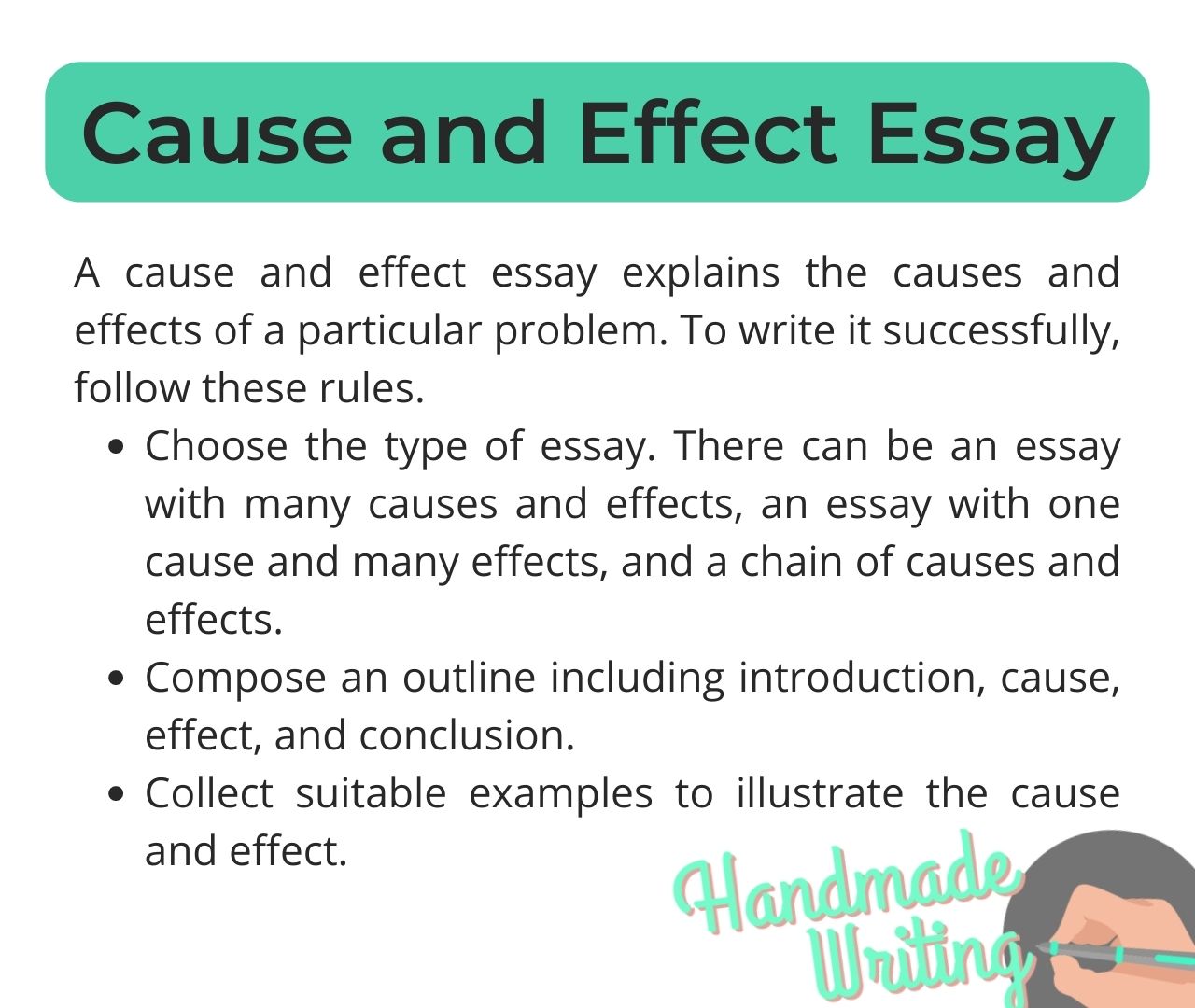
If you can see the logic behind cause and effect in the world around you, you will encounter fewer problems when writing. If not, writing this kind of paper will give you the chance to improve your skillset and your brain’s ability to reason.
“Shallow men believe in luck or in circumstance. Strong men believe in cause and effect.” ― Ralph Waldo Emerson
In this article, the Handmade Writing team will find out how to create an outline for your cause and effect essay – the key to successful essay writing.
Types of the Cause and Effect Essay
Before writing this kind of essay, you need to draft the structure. A good structure will result in a good paper, so it’s important to have a plan before you start. But remember , there’s no need to reinvent the wheel: just about every type of structure has already been formulated by someone.
If you are still unsure about the definition of an essay, you can take a look at our guide: What is an Essay?
Generally speaking, there are three types of cause and effect essays. We usually differentiate them by the number of and relationships between the different causes and the effects. Let’s take a quick look at these three different cases:
1. Many causes, one effect
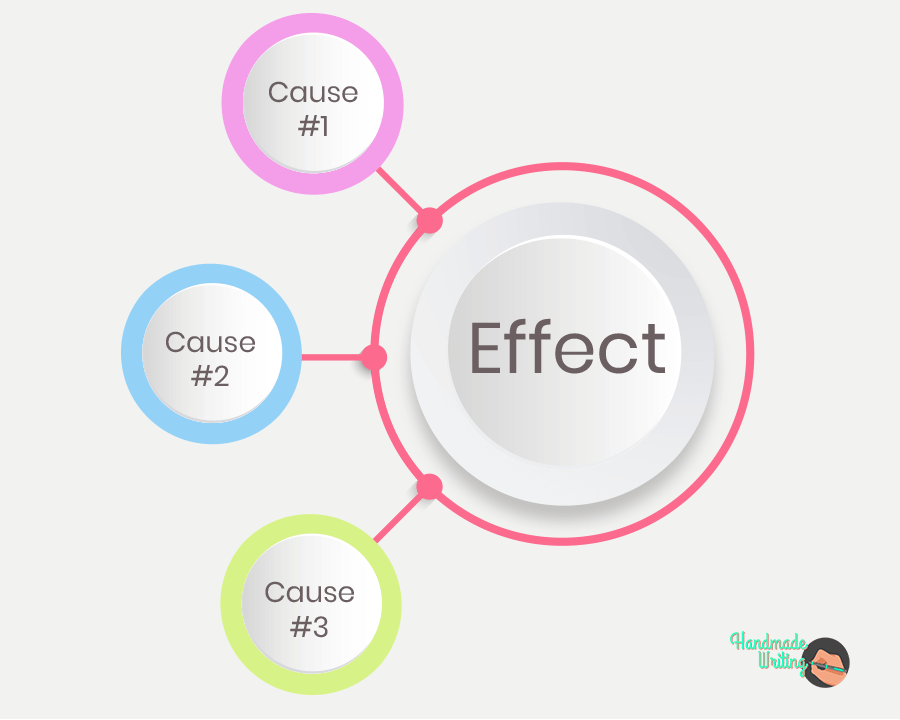
This kind of essay illustrates how different causes can lead to one effect. The idea here is to try and examine a variety of causes, preferably ones that come from different fields, and prove how they contributed to a particular effect. If you are writing about World War I, for example, mention the political, cultural, and historical factors that led to the great war.
By examining a range of fundamental causes, you will be able to demonstrate your knowledge about the topic.
Here is how to structure this type of essay:
- Introduction
- Cause #3 (and so on…)
- The effect of the causes
2. One cause, many effects

This type of cause and effect essay is constructed to show the various effects of a particular event, problem, or decision. Once again, you will have to demonstrate your comprehensive knowledge and analytical mastery of the field. There is no need to persuade the reader or present your argument . When writing this kind of essay, in-depth knowledge of the problem or event’s roots will be of great benefit. If you know why it happened, it will be much easier to write about its effects.
Here is the structure for this kind of essay:
- Effect #3 (and so on…)
3. Chain of causes and effects
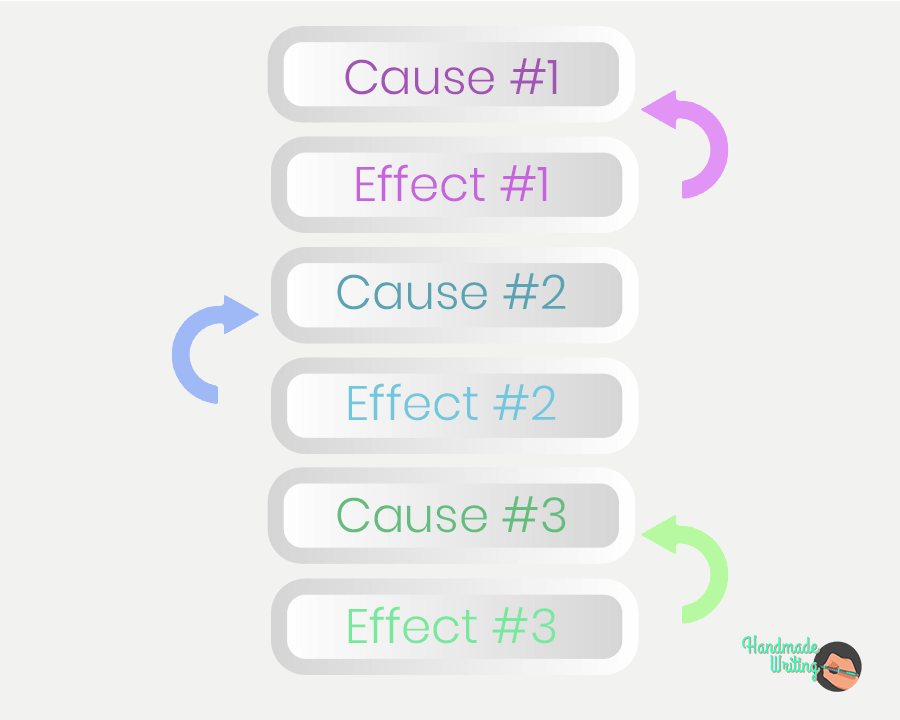
This is the most challenging type. You need to maintain a chain of logic that demonstrates a sequence of actions and consequences, leading to the end of the chain. Although this is usually the most interesting kind of cause and effect essay, it can also be the most difficult to write.
Here is the outline structure:
- Effect #1 = Cause #2
- Effect #2 = Cause #3
- Effect #3 = Cause #4 (and so on…)
Cause and Effect Essay Outline Example
Let’s take a look at an example. Below, you will find an outline for the topic “The causes of obesity” (Type 1) :
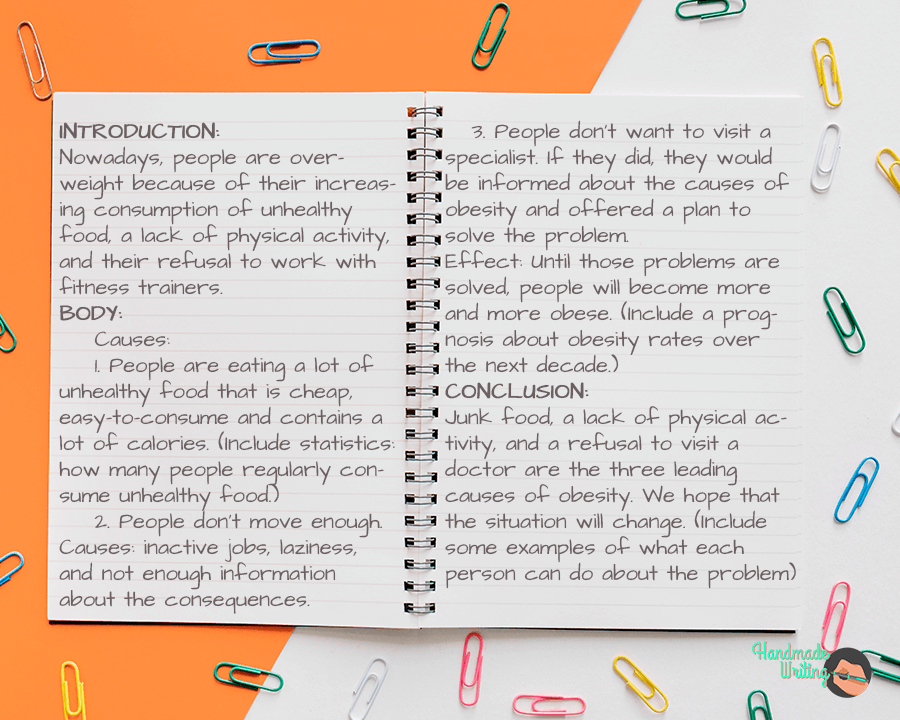
As you can see, we used a blended strategy here. When writing about the ever-increasing consumption of unhealthy food, it is logical to talk about the marketing strategies that encourage people to buy fast food. If you are discussing fitness trainers, it is important to mention that people need to be checked by a doctor more often, etc.
In case you face some issues with writing your Cause and Effect essay, you can always count on our Essay Writers !
How do I start writing once I have drafted the structure?
If you start by structuring each paragraph and collecting suitable examples, the writing process will be much simpler. The final essay might not come up as a classic five paragraph essay – it all depends on the cause-effect chain and the number of statements of your essay.
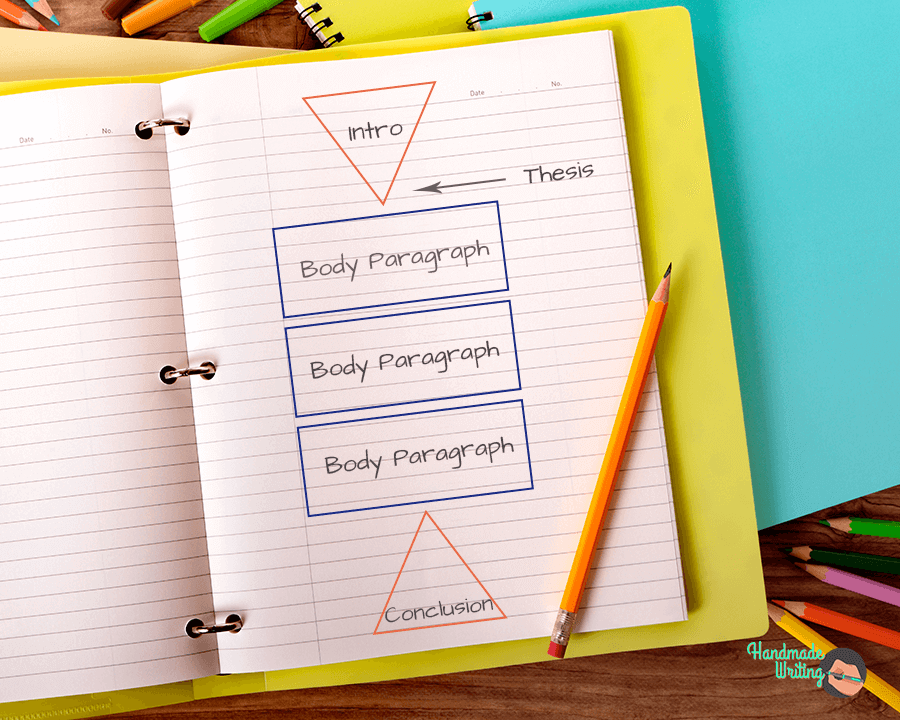
In the Introduction, try to give the reader a general idea of what the cause and effect essay will contain. For an experienced reader, a thesis statement will be an indication that you know what you are writing about. It is also important to emphasize how and why this problem is relevant to modern life. If you ever need to write about the Caribbean crisis, for instance, state that the effects of the Cold War are still apparent in contemporary global politics.
Related Post: How to write an Essay introduction | How to write a Thesis statement
In the Body, provide plenty of details about what causes led to the effects. Once again, if you have already assembled all the causes and effects with their relevant examples when writing your plan, you shouldn’t have any problems. But, there are some things to which you must pay particular attention. To begin with, try to make each paragraph the same length: it looks better visually. Then, try to avoid weak or unconvincing causes. This is a common mistake, and the reader will quickly realize that you are just trying to write enough characters to reach the required word count.
Moreover, you need to make sure that your causes are actually linked to their effects. This is particularly important when you write a “chained” cause and effect essay (type 3) . You need to be able to demonstrate that each cause was actually relevant to the final result. As I mentioned before, writing the Body without preparing a thorough and logical outline is often an omission.
The Conclusion must be a summary of the thesis statement that you proposed in the Introduction. An effective Conclusion means that you have a well-developed understanding of the subject. Notably, writing the Conclusion can be one of the most challenging parts of this kind of project. You typically write the Conclusion once you have finished the Body, but in practice, you will sometimes find that a well-written conclusion will reveal a few mistakes of logic in the body!
Cause and Effect Essay Sample
Be sure to check the sample essay, completed by our writers. Use it as an example to write your own cause and effect essay. Link: Cause and effect essay sample: Advertising ethic issues .
Tips and Common Mistakes from Our Expert Writers

Check out Handmadewriting paper writing Guide to learn more about academic writing!

A life lesson in Romeo and Juliet taught by death
Due to human nature, we draw conclusions only when life gives us a lesson since the experience of others is not so effective and powerful. Therefore, when analyzing and sorting out common problems we face, we may trace a parallel with well-known book characters or real historical figures. Moreover, we often compare our situations with […]

Ethical Research Paper Topics
Writing a research paper on ethics is not an easy task, especially if you do not possess excellent writing skills and do not like to contemplate controversial questions. But an ethics course is obligatory in all higher education institutions, and students have to look for a way out and be creative. When you find an […]

Art Research Paper Topics
Students obtaining degrees in fine art and art & design programs most commonly need to write a paper on art topics. However, this subject is becoming more popular in educational institutions for expanding students’ horizons. Thus, both groups of receivers of education: those who are into arts and those who only get acquainted with art […]
Cause And Effect Essay Writing

How to Write Cause and Effect Essays in Simple Steps
11 min read
Published on: Mar 13, 2020
Last updated on: Mar 25, 2024

People also read
Learn How to Create a Cause and Effect Essay Outline
Top Cause and Effect Essay Topics to Impress Your Readers
Share this article
Are you struggling to wrap your head around cause and effect essays? Don’t worry; you’re not alone.
These essays might seem complex at first glance, but with the right approach, they can become easier to write.
In this comprehensive guide, we'll look into what cause and effect essays are, how to structure them, and provide valuable tips and examples to help you understand this type of writing.
On This Page On This Page -->
What is a Cause and Effect Essay?
A cause and effect essay is a type of essay writing that explores the relationship between events, actions, or phenomena (causes) and their outcomes or consequences (effects) .
In this type of essay, the writer analyzes how one event leads to another, providing insights into the underlying causes and the resulting effects. Cause and effect essays aim to explain the connections between various occurrences and explain the reasons behind certain outcomes.
They often require critical thinking, careful analysis, and the use of evidence and examples to support arguments.
You may confuse cause-and-effect essays with compare and contrast essays . While cause and effect essays focus on analyzing the relationship between events, compare and contrast essays examine similarities and differences between two or more subjects or ideas.
How to Structure a Cause and Effect Essay
There are two main structural types commonly used to write a cause and effect essay: the block structure and the chain structure.
Block Structure
In the block structure, the writer first discusses all the causes of the event in one section, followed by a separate section dedicated to discussing all the effects.
This cause and effect essay format allows for a clear separation between the causes and effects, making it easier for the reader to understand the relationships between them.
|
Use the block structure when:
- There are multiple causes and effects to discuss, and you want to provide a comprehensive overview of each.
- You prefer a clear separation between causes and effects for easier understanding.
Chain Structure
In the chain structure, each cause is followed immediately by its corresponding effect(s), creating a chain-like sequence of events.
This structure emphasizes the direct relationship between each cause and its effect, providing a more immediate and interconnected narrative.
|
Use the chain structure when:
- You want to emphasize the direct relationship between each cause and its effect.
- You're discussing a series of events that occur in a linear or chronological order.
Cause and Effect Essay Outline
Creating an outline is essential for organizing your thoughts and structuring your cause and effect essay effectively.
Here's a basic outline to guide you through the writing process:
Start with an attention-grabbing statement or question to engage the reader. Provide context and background information on the topic. Clearly state the main causes and effects you will discuss in your essay.
Introduction to Causes Introduce the first cause you will discuss. Provide an explanation of the cause and its significance. Support your explanation with relevant examples or evidence.Introduce the effects resulting from the first cause. Discuss the consequences or outcomes of the cause. Provide examples or evidence to illustrate the effects. Repeat the above structure for each additional cause and its corresponding effects. Summarize the main causes and effects discussed in the essay. Highlight the connections between the causes and effects. End with a thought-provoking statement or suggestion for further exploration of the topic. |
Need a detailed outline guide? Be sure to check out our blog on " Cause and Effect Essay Outline " for a comprehensive breakdown of how to organize your essay.
How to Write a Cause and Effect Essay
Writing a cause and effect essay involves examining the reasons (causes) and outcomes (effects) of a particular event, phenomenon, or situation. Here's a step-by-step guide to help you craft an effective cause and effect essay:
Step 1: Choose a Topic
Start by selecting a topic that interests you and has clear cause-and-effect relationships. It could be a social issue, scientific phenomenon, historical event, or any other subject with identifiable causes and effects.
For example, "The Effects of Climate Change on Wildlife Populations" or "Causes of Obesity in Developed Countries."
Step 2: Conduct Research
Gather relevant information and evidence to support your thesis statement . Look for credible sources such as academic journals, books, government reports, and reputable websites.
Ensure you have a thorough understanding of both the causes and effects related to your chosen topic.
Step 4: Develop a Thesis Statement
Craft a clear and concise thesis statement that outlines the main causes and effects you will discuss in your essay. Your thesis should provide a roadmap for the reader and clearly state your position on the topic.
For instance, "The rise in carbon emissions from human activities is leading to severe consequences for global ecosystems."
Step 5: Outline your Essay
Create a structured outline that organizes your ideas and arguments logically. Divide your essay into introduction , body paragraphs (each discussing a specific cause or effect), and conclusion .
Each body paragraph should focus on one cause or effect and provide supporting details and evidence.
Step 6: Write the Introduction
Begin with an engaging introduction that provides background information on the topic and introduces your thesis statement.
Hook the reader's attention with an interesting fact, statistic, or anecdote related to your topic. Clearly state the purpose of your essay and preview the main points you will discuss.
In recent years, the proliferation of social media platforms has revolutionized the way people communicate, connect, and consume information. While these platforms offer numerous benefits such as instant communication and global networking, they have also been associated with various negative effects on mental health. This essay explores the causes behind the rise of social media and its detrimental effects on individuals' mental well-being. |
Step 7: Body Paragraphs
In the body paragraphs, explore the causes or effects of the topic in detail. Start each paragraph with a topic sentence that introduces the cause or effect you will be discussing.
Then, provide evidence and examples to support your claim. Use data, statistics, expert opinions, and real-life examples to strengthen your arguments. Make sure to explain the causal relationship between the factors you're discussing.
One of the primary causes behind the surge in social media usage is the widespread availability of smartphones and internet access. With the advent of affordable smartphones and widespread internet connectivity, people have constant access to social media platforms, leading to increased usage. Additionally, the addictive nature of social media interfaces, characterized by endless scrolling and notifications, further fuels this phenomenon. As individuals spend more time on social media, they become increasingly dependent on these platforms for social validation, entertainment, and information.
The excessive use of social media has been linked to various detrimental effects on mental health, including increased feelings of anxiety, depression, and loneliness. Constant exposure to carefully curated images and lifestyles on social media can create unrealistic expectations and foster feelings of inadequacy among users. Moreover, the prevalence of cyberbullying and online harassment on these platforms can exacerbate existing mental health issues and lead to social withdrawal. Studies have shown a correlation between heavy social media usage and poor sleep quality, as individuals often sacrifice sleep to engage with online content, further compromising their mental well-being. |
Step 8: Transition Between Paragraphs
Use transition words and sentences to smoothly transition between paragraphs and maintain coherence throughout your essay.
These transitions help guide the reader through your arguments and ensure a logical flow of ideas.
Step 9: Write the Conclusion
Summarize the main points of your essay in the conclusion and restate your thesis statement. Reflect on the significance of your findings and emphasize the importance of understanding the causes and effects of the topic.
Avoid introducing new information in the conclusion; instead, offer insights or suggestions for further research or action.
In conclusion, the rise of social media has had profound implications for individuals' mental health, driven by factors such as increased smartphone usage and the addictive nature of social media platforms. While social media offers unparalleled opportunities for communication and connection, its negative effects on mental well-being cannot be ignored. It is essential for individuals to strike a balance between online and offline interactions and practice mindfulness while using social media to mitigate its adverse effects on mental health. Additionally, further research and awareness efforts are needed to address the underlying causes and consequences of excessive social media usage in society. |
Step 10: Revise and Edit
Review your essay for clarity, coherence, and grammatical accuracy. Make sure each paragraph contributes to the overall argument and that your ideas are well-supported by evidence.
Once you've made revisions and edits, finalize your essay by formatting it according to the guidelines provided by your instructor or publication.
Double-check citations and references to ensure they are accurate and properly formatted according to the required citation style (e.g., APA, MLA).
Cause and Effect Essay Examples
When writing a cause and effect essay for the first time, it is recommended to go through a few examples. It will help you understand the structure and how to use a method effectively.
The following are some of the great cause and effect examples free to use.
Cause and Effect Essay
Cause and Effect Essay Sample
Climate Change Cause and Effect Essay
Poverty Cause and Effect Essay
Air Pollution Cause and Effect Essay
Cause and Effect Essay Topics
Here are some cause and effect essay topics:
- The Impact of Climate Change on Extreme Weather Events
- The Rise of Mental Health Disorders Among Adolescents
- The Effects of Social Media on Political Polarization
- The Consequences of Deforestation on Biodiversity Loss
- The Relationship Between Income Inequality and Social Mobility
- The Impact of Technology on Human Relationships
- The Causes and Effects of the Global Obesity Epidemic
- The Effects of Air Pollution on Public Health
- The Impact of Artificial Intelligence on Employment
- The Causes and Consequences of Refugee Crises
These topics reflect current societal concerns and offer opportunities for in-depth analysis of cause-and-effect relationships. If you need more such ideas check out our cause and effect essay topics blog!
Tips for Writing a Cause and Effect Essay
Here are additional tips for writing a cause and effect essay:
- Establish Clear Connections: Clearly establish the causal relationships between different factors to help readers understand the cause-and-effect dynamics of the topic.
- Avoid Oversimplification: Recognize that most events have multiple causes and effects, so avoid oversimplifying complex phenomena by considering various factors and their interactions.
- Consider Chronology: When discussing historical events, consider the chronological sequence of causes and effects to provide a clear narrative structure.
- Focus on Significance: Highlight the significance of your findings by discussing the broader implications of the causes and effects you've identified.
- Reflect and Synthesize: In the conclusion, reflect on the insights gained from analyzing the causes and effects and synthesize your findings to provide a cohesive understanding of the topic.
To conclude, writing a cause and effect essay can be a rewarding experience that allows you to look into complex issues. By following the guidelines outlined in this guide and applying your critical thinking skills, you can create compelling essays that inform and engage your audience.
But if you are in a time crunch do not hesitate to take professional help. CollegeEssay.org provides a top cause and effect essay writing service for those students who are having a hard time meeting deadlines. We'll help you with your cause and effects essays for the best grades.
Reach out to avail amazing discounts and get our custom essay writing help in no time. As a plus, you can use our AI writing tool if you need a quick fix to beat the deadline stress!
Cathy A. (Literature, Marketing)
For more than five years now, Cathy has been one of our most hardworking authors on the platform. With a Masters degree in mass communication, she knows the ins and outs of professional writing. Clients often leave her glowing reviews for being an amazing writer who takes her work very seriously.
Paper Due? Why Suffer? That’s our Job!

Keep reading

Legal & Policies
- Privacy Policy
- Cookies Policy
- Terms of Use
- Refunds & Cancellations
- Our Writers
- Success Stories
- Our Guarantees
- Affiliate Program
- Referral Program
- AI Essay Writer
Disclaimer: All client orders are completed by our team of highly qualified human writers. The essays and papers provided by us are not to be used for submission but rather as learning models only.
)
How to Write a Cause and Effect Essay
Published September 27, 2020. Updated May 19, 2022.
Cause and Effect Essay Definition
A cause and effect essay explains why events happen (causes), what results (effects), and the relationship between the cause and effect(s).
Overview of a Cause and Effect Essay
Cause and effect essays are commonly structured in four ways: causal chain, causes, effects, and causes and effects. Once you decide on a structure, you should choose your topic. You may already have some causes and/or effects in mind. Brainstorm to come up with ideas. Brainstorming helps you think more about your topic and gives you a good selection of causes and effects to choose from. Choose what causes and effects to focus on. Develop a discussion of the causes and effects to build a case for the plausibility of these causes and effects and their relationship.
Worried about your writing? Submit your paper for a Chegg Writing essay check , or for an Expert Check proofreading . Both can help you find and fix potential writing issues.
Step 1: Choose a Focus
Cause and effect essays are commonly structured in four ways:
- Causal chain
- Causes & effects
Start by considering the length of your essay and other requirements. Follow the focus and topic assigned by your instructor. Otherwise, choose the option that is best for you.
Causal Chain
A causal chain follows a specific sequence of causes and effects. It starts with an initial topic and then moves forward, identifying a specific effect of this topic. This effect, then, causes another effect, and so on down the chain.
Topic → leads to A → leads to B → leads to C → final effect
A causal chain is a good structure if you want to build up to a certain key effect of the topic and show the reader the steps it takes to get there.
The causal chain structure works well for either a short (2-3 pages) or a long (4+ pages) essay, depending on how many steps you need to discuss to reach the final effect.
When you focus on causes, start with a topic you’re interested in and think about what caused it? In a way, you’re looking backward to understand the factors that caused something or that keep it happening.
Causes → Topic
This is good for a short essay because the scope is limited to focusing on causes.
If you focus on effects, start with a topic and work forward by asking what happens due to this event or topic? What are its effects?
Topic → Effects
Effects may be in the future. For example, if a certain law is passed, what will be the most likely outcome? We can’t know for sure until it happens, but we can use existing factors and logical reasoning to make a case for certain possibilities.
You could also focus on effects that are occurring or that have occurred. For example, what effects do video games have on a certain age group? This might also allow you to focus your analysis on an existing debate. In this example, the nature of the effects of video games on children is a common topic of debate.
This is good for a short essay because what you are covering is limited to effects.
Causes and Effects
With this focus, you’d consider what makes something happen and what its effects are.
Causes → Topic → Effects
If you are writing a longer essay, you could consider discussing both causes and effects. This wider scope could result in a more thorough examination of the topic. But make sure not to set yourself up to do too much. You don’t have to touch on every cause and effect you brainstorm. Rather, your focus should relate to your purpose. Remembering your focus allows you to screen out the causes and effects that aren’t relevant to your purpose.
The cause and effect structure is good for a longer essay (4 or more pages) because you’ll have to cover more material.
Step 2: Choose a Topic
Now that you’ve decided on a focus, what do you want to write about? Your assignment prompt might give you some direction, but if the essay is open-topic, consider what you’d be interested in writing about. Here are some ideas to help you choose:
Consider Your Purpose
You want to have an end goal, a purpose. You’re discussing causes and effects, but why? To show people what? To convince people of what? For example, you could analyze effects for the purpose of showing that video games help teenagers develop good teamwork and decision-making skills.
At first, you might think about what you want to learn or explore. Maybe you’ve found that jobs in a career field you’re interested in are increasing or decreasing, and you’d like to explore the causes for that. Maybe you’d like to explore the effects of companies allowing employees to work from home. If your research leads you to conclude that these effects are mostly positive, you might focus your purpose on convincing employers to offer more work-from-home flexibility. To do that, you’d analyze the effects.
Consider Your Audience
Consider your audience can help you focus your topic and develop content. What are the relevant characteristics of your audience? What are their likely questions, concerns, or biases? Answering these questions helps you decide what to focus on. If your audience is owners or leaders of a struggling business, you could analyze the causes of their poor sales to help them improve. This example shows the connection between audience and purpose.
A phenomenon is something noteworthy or special that stands out. The topic could be from pop culture, science, current events, or anything else. You could make an argument for the causes of a movie’s popularity or explore why a particular age group favors a certain social media platform. Topics are everywhere!
Trend , as used here, doesn’t mean a fad, but rather, something that rises or falls in popularity over time.
If you write on a trend, decide the beginning and end of the period you will be discussing. For instance, the rise of women in the workforce starting from WWII makes sense because with men fighting in the war, women had to step into several key industries normally dominated by men. However, if you tried to discuss significant causes of the increase of women in the workforce from WWII to the present, you’d probably find that to be too long of a period of time to discuss thoroughly.
Step 3: Brainstorm Causes and Effects
You may already have some causes and effects in mind. Keep brainstorming to come up with more. You won’t write about everything, but brainstorming helps you think more about your topic and gives you a good selection of causes and effects to choose from.
As you brainstorm, consider different types of causes and effects.
Surface Causes and Effects
Surface causes and effects are obvious. They come immediately to mind, and their connection to the topic is clear or well-known. For example, the connection between smoking and lung damage. Because of this, surface causes and effects usually don’t need extensive development. While they could have a role in your essay, you wouldn’t want to focus solely on obvious causes and effects.
Below-the-Surface Causes and Effects
These are not immediately obvious. This doesn’t mean they’re baseless “conspiracy theory” ideas, but that they’re not things people would immediately know or think of. They might be more complicated or even rarely acknowledged on a conscious level. These might not even occur to you until you’ve done more research and thought more about the topic. Below-the-surface causes and effects take more work to develop in an essay, but they are generally more intriguing.
Immediate Causes and Effects
Immediate causes and effects happen right before or after the topic. Because of this proximity, they are often more obvious, although they are not necessarily simple.
Remote or Background Causes and Effects
These happen well before or after the topic. You’ll have to think about the length of time that makes sense for your topic. If you are considering the increase of women in the workforce, considering WWII probably makes sense, even though it was over seventy years ago. However, if you are speculating about the causes of the popularity of Facebook, seventy years in the past is too far.
Perpetuating Causes
Perpetuating causes not only make something happen but also keep it going as well. Such causes perpetuate the topic.
Step 4: Choose What Causes and Effects to Focus On
Use these ideas to help you decide what causes and effects to focus on:
- Does your prompt tell you how many causes and effects to cover? Make sure to follow assignment instructions.
- Choose causes and effects that help you accomplish your purpose.
- Choose causes and effects relevant to your audience.
- You might notice that certain causes/effects cluster around a particular idea or theme. You could choose to focus on that theme.
- What types of causes and effects did you brainstorm? It will take more effort and writing space to develop an argument for the plausibility of a below-the-surface cause than a surface cause. Don’t take on more complicated causes and effects than you can develop in your page range.
- Don’t go the route of using lots of obvious causes and effects. These won’t give you the chance to develop an in-depth analysis and your paper might end up more like a list.
Before you turn in that paper, don’t forget to cite your sources in APA format , MLA format , or a style of your choice.
Step 5: Develop a Discussion of Your Causes and Effects
You are looking for connections between the causes and the effects of the topic. You’re building a case for the plausibility of these causes and effects.
Have a working thesis in mind. You’ll probably refine it as you go.
Make sure to avoid the false causality logical fallacy . This can also be expressed as “coincidence doesn’t equal causation.” That one event precedes another does not make the first event a cause of another. It’s up to you as the writer to establish a firm causal link.
Think about the order in which you present the causes and effects. There might be some that form a foundation for understanding others. There might also be a chronological sequence, especially if you are following a causal chain. You might also choose to develop your most compelling cause or effect.
Example Cause and Effect Essay on the Internet’s Influence on Young Adults
By Ericka Scott Nelson. Ericka earned a MA in English from the University of California, Riverside. She teaches composition at a community college.
Common Writing Assignments, Apps & Tests
- Analytical Essay
- AP synthesis Essay
- Argumentative Essay
- Book Report
- Compare and Contrast Essay
- Cause and Effect Essay
- College Admissions Essay
- Critical Analysis Essay
- Definition Essay
- Descriptive Essay
- Dissertation
- Explanatory Essay
- Expository Essay
- Informative Essay
- Narrative Essay
- Opinion Essay
- Personal Essay
- Persuasive Essay
- Reflective Essay
- Research Paper
- Rhetorical Analysis
- Scholarship Essay
- Short Essay
- Thesis Paper

What’s included with a Chegg Writing subscription
- Unlimited number of paper scans
- Plagiarism detection: Check against billions of sources
- Expert proofreading for papers on any subject
- Grammar scans for 200+ types of common errors
- Automatically create & save citations in 7,000+ styles
- Cancel subscription anytime, no obligation
Cause and Effect in Composition
Glossary of Grammatical and Rhetorical Terms
- An Introduction to Punctuation
- Ph.D., Rhetoric and English, University of Georgia
- M.A., Modern English and American Literature, University of Leicester
- B.A., English, State University of New York
In composition , cause and effect is a method of paragraph or essay development in which a writer analyzes the reasons for—and/or the consequences of—an action, event, or decision.
A cause-and-effect paragraph or essay can be organized in various ways. For instance, causes and/or effects can be arranged in either chronological order or reverse chronological order. Alternatively, points can be presented in terms of emphasis , from least important to most important, or vice versa.
Examples and Observations
- "If you prove the cause , you at once prove the effect ; and conversely nothing can exist without its cause." (Aristotle, Rhetoric )
- Immediate Causes and Ultimate Causes "Determining causes and effects is usually thought-provoking and quite complex. One reason for this is that there are two types of causes: immediate causes , which are readily apparent because they are closest to the effect, and ultimate causes , which, being somewhat removed, are not so apparent and may perhaps even be hidden. Furthermore, ultimate causes may bring about effects which themselves become immediate causes, thus creating a causal chain . For example, consider the following causal chain: Sally, a computer salesperson, prepared extensively for a meeting with a client (ultimate cause), impressed the client (immediate cause), and made a very large sale (effect). The chain did not stop there: the large sale caused her to be promoted by her employer (effect)." (Alfred Rosa and Paul Eschholz, Models for Writers , 6th ed. St. Martin's Press, 1998)
- Composing a Cause/Effect Essay "For all its conceptual complexity, a cause/effect essay can be organized quite simply. The introduction generally presents the subject(s) and states the purpose of the analysis in a clear thesis . The body of the paper then explores all relevant causes and/or effects, typically progressing from least to most influential or from most to least influential. Finally, the concluding section summarizes the various cause/effect relationships established in the body of the paper and clearly states the conclusions that can be drawn from those relationships." (Kim Flachmann, Michael Flachmann, Kathryn Benander, and Cheryl Smith, The Brief Prose Reader . Prentice Hall, 2003)
- Causes of Child Obesity "Many of today's kids are engaged in sedentary pursuits made possible by a level of technology unthinkable as recently as 25 to 30 years ago. Computer, video, and other virtual games, the ready availability of feature films and games on DVD, plus high-tech advancements in music-listening technology have come down into the range of affordability for parents and even for the kids themselves. These passive pursuits have produced a downside of reduced physical activity for the kids, often with the explicit or implicit consent of the parents. . . . "Other fairly recent developments have also contributed to the alarming rise in child obesity rates. Fast food outlets offering consumables that are both low in price and low in nutritional content have exploded all over the American landscape since the 1960s, especially in suburban areas close to major highway interchanges. Kids on their lunch breaks or after school often congregate in these fast food outlets, consuming food and soft drinks that are high in sugar, carbohydrates, and fat. Many parents, themselves, frequently take their children to these fast food places, thus setting an example the kids can find justification to emulate." (MacKie Shilstone, Mackie Shilstone's Body Plan for Kids . Basic Health Publications, 2009)
- Cause and Effect in Jonathan Swift's "A Modest Proposal" "'A Modest Proposal' is a brilliant example of the use of non-argumentative devices of rhetorical persuasion . The whole essay, of course, rests broadly upon the argument of cause and effect : these causes have produced this situation in Ireland, and this proposal will result in these effects in Ireland. But Swift, within the general framework of this argument, does not employ specific argumentative forms in this essay. The projector chooses rather to assert his reasons and then to amass them by way of proof ." (Charles A. Beaumont, Swift's Classical Rhetoric . Univ. of Georgia Press, 1961)
- Effects of Automobiles "I worry about the private automobile. It is a dirty, noisy, wasteful, and lonely means of travel. It pollutes the air, ruins the safety and sociability of the street, and exercises upon the individual a discipline which takes away far more freedom than it gives him. It causes an enormous amount of land to be unnecessarily abstracted from nature and from plant life and to become devoid of any natural function. It explodes cities, grievously impairs the whole institution of neighborliness, fragmentizes and destroys communities. It has already spelled the end of our cities as real cultural and social communities, and has made impossible the construction of any others in their place. Together with the airplane, it has crowded out other, more civilized and more convenient means of transport, leaving older people, infirm people, poor people and children in a worse situation than they were a hundred years ago." (George F. Kennan, Democracy and the Student Left , 1968)
- Examples and Effects of Entropy "Because of its unnerving irreversibility, entropy has been called the arrow of time. We all understand this instinctively. Children's rooms, left on their own, tend to get messy, not neat. Wood rots, metal rusts, people wrinkle and flowers wither. Even mountains wear down; even the nuclei of atoms decay. In the city we see entropy in the rundown subways and worn-out sidewalks and torn-down buildings, in the increasing disorder of our lives. We know, without asking, what is old. If we were suddenly to see the paint jump back on an old building, we would know that something was wrong. If we saw an egg unscramble itself and jump back into its shell, we would laugh in the same way we laugh as a movie run backward." (K.C. Cole, "The Arrow of Time." The New York Times , March 18, 1982)
- Affect vs. Effect: How to Choose the Right Word
- Understanding General-to-Specific Order in Composition
- Definition and Examples of the Topoi in Rhetoric
- What Is an Annotation in Reading, Research, and Linguistics?
- How to Use Exemplification in Writing
- Polemic: Definition and Examples
- Learn How to Use Extended Definitions in Essays and Speeches
- Understanding Organization in Composition and Speech
- Periodical Essay Definition and Examples
- What Does It Mean to Make a Claim During an Argument?
- Definition and Examples of Formal Essays
- Definition and Examples of Propaganda
- Definition and Examples of Humorous Essays
- Organizational Strategies for Using Chronological Order in Writing
- Definition Examples of Collage Essays

Want to create or adapt books like this? Learn more about how Pressbooks supports open publishing practices.
17 Rhetorical Modes for Paragraphs & Essays
Questions to Ponder
Before you read this chapter, discuss with partners:
- What are rhetorical modes (also called “patterns of organization” and “methods of development”)? Can you list some examples?
- Why are rhetorical modes important in writing? Jot down your ideas.

Now read the graphic below. Can you add to the list of rhetorical modes that you created with your partners?

Rhetorical Modes
Rhetorical modes are also called patterns of organization or methods of development ; they are the ways that authors and speakers organize their ideas to communicate effectively. The rhetorical modes that are covered here are best used as ways to look at what’s already happening in your draft and to consider how you might emphasize or expand on any existing patterns. You might already be familiar with some of these patterns because instructors will sometimes assign them as the purpose for writing an essay. For example, you might have been asked to write a cause and effect essay or a comparison and contrast essay.
Patterns of organization or methods of developing content usually happen naturally as a consequence of the way the writer engages with and organizes information while writing. That is to say, most writers don’t sit down and say, “I think I’ll write a cause and effect essay today.” Instead, a writer might be more likely to be interested in a topic, say, the state of drinking water in the local community, and as the writer begins to explore the topic, certain cause and effect relationships between environmental pollutants and the community water supply may begin to emerge . And in fact, many times, one essay may incorporate two or more rhetorical modes, as the author makes an argument for their point of view.
Activity A ~ Brainstorming Rhetorical Modes
Pause here to brainstorm ideas with your partner. Using the chart above (“ Choosing Paragraph Patterns “), discuss some of the topics below. Which mode(s) might you use in an essay about these topics? Would you need to explore more than one rhetorical mode for each topic?
- Gender roles
- Race in America
- The value of art in society
- Travel as part of a well-rounded education
- Drugs and alcohol
- Advice to new parents
- Advice to teachers
- The value of making mistakes
- How you’d spend a million dollars
- What a tough day at work taught you about yourself or others
- My family history
- Your idea: ___________
Keep reading to consider some of the ways that these strategies can help you as you revise a draft.
Cause/Effect
Do you see a potential cause-and-effect relationship developing in your draft? The cause/effect pattern may be used to identify one or more causes followed by one or more effects or results. Or you may reverse this sequence and describe effects first and then the cause or causes. For example, the causes of water pollution might be followed by its effects on both humans and animals. Use the signal words cause , effect , and result , to cue the reader about your about the relationships that you’re establishing.
Here’s an example article from T he New York Times , “ Rough Times Take Bloom Off a New Year’s Rite, the Rose Parade ,” that explores the cause and effect relationship (from 2011) between Pasadena’s budgetary challenges and the ability of their Rose Parade floats to deck themselves out in full bloom.
Problem/Solution
At some point does your essay explore a problem or suggest a solution? The problem/solution pattern is commonly used in identifying something that’s wrong and in contemplating what might be done to remedy the situation. For example, the problem of water pollution could be described, followed by ideas of new ways to solve the problem. There are probably more ways to organize a problem/solution approach, but here are three possibilities:
- Describe the problem, followed by the solution
- Propose the solution first and then describe the problems that motivated it
- Explain a problem, followed by several solutions, and select one solution as the best
Emphasize the words problem and solution to signal these sections of your paper for your reader.
Here’s an example article from T he New York Times , “ Monks Embrace Web to Reach Recruits ,” that highlights an unexpected approach by a group of Benedictine monks in Rhode Island; they’ve turned to social media to grow their dwindling membership.
Compare/Contrast
Are you trying to define something? Do you need your readers to understand what something is and what it is not? The compare-and-contrast method of development is particularly useful in extending a definition, or anywhere you need to show how a subject is like or unlike another subject. For example, the statement is often made that drug abuse is a medical problem instead of a criminal justice issue. An author might attempt to prove this point by comparing drug addiction to AIDS, cancer, or heart disease to redefine the term “addiction” as a medical problem. A statement in opposition to this idea could just as easily establish contrast by explaining all the ways that addiction is different from what we traditionally understand as an illness. In seeking to establish comparison or contrast in your writing, some words or terms that might be useful are by contrast , in comparison , while , some , and others .
Here’s an example article from T he New York Times “ Who Wants to Shop in a Big Box Store, Anyway? ” The author explores some interesting differences between the average American and average Indian consumer to contemplate the potential success of big box stores in India and also to contemplate why these giant big box corporations, like Walmart or Target, might have to rethink their business model.

These three methods of development—cause/effect, problem/solution, and compare/contrast—are just a few ways to organize and develop ideas and content in your essays. It’s important to note that they should not be a starting point for writers who want to write something authentic, to discuss something that they care deeply about. Instead, they can be a great way to help you look for what’s already happening with your topic or in a draft, to help you to write more, or to help you reorganize some parts of an essay that seem to lack connection or feel disjointed.
Sometimes writers incorporate a variety of modes in any one essay. For example, under the umbrella of an argument essay, and author might choose to write paragraphs showing cause and effect, description, and narrative. The rhetorical mode writers choose depends on the purpose for writing. Rhetorical modes are a set of tools that will give you greater flexibility and effectiveness in communicating with your audience and expressing ideas.
In addition to cause/effect , problem/solution , and compare/contrast , there are many other types of rhetorical modes:
- Classification and division , often used in science, takes large ideas and divides them into manageable chunks of information, classifying and organizing them into types and parts.
- Definition clarifies the meaning of terms and concepts, providing context and description for deeper understanding of those ideas.
- Description provides detailed information using adjectives that appeal to the five senses (what people see, hear, smell, taste, and touch) as well as other vivid details that help readers visualize or understand an item or concept.
- Evaluation analyzes and judges the value and merit of an essay, a concept, or topic.
- Illustration provides examples and evidence in detail to support, explain, and analyze a main point or idea.
- Narrative uses fictional or nonfictional stories in a chronological sequence of events, often including detailed descriptions and appeals to the senses and emotions of readers while storytelling to reveal a theme or moment.
- Persuasion (i.e., argumentation) logically attempts to convince readers to agree with an opinion or take an action; the argument also acknowledges opposing viewpoints and accommodates and/or refutes them with diplomatic and respectful language, as well as provides precise and accurate evidence and other expert supporting details.
- Process analysis describes and explains, step by step, chronologically, in detail, and with precision and accuracy, how to do something or how something works.
Assignment prompts for college essays may require a specific rhetorical mode, or you may be able to choose the best mode(s) to express your ideas clearly. Either way, be sure to ask your instructor if you are not sure which rhetorical mode(s) to use.
Key Takeaways
Why are rhetorical modes important?
- As readers, understanding an author’s rhetorical mode helps us to understand the text, and to read and think critically.
- Knowing the rhetorical mode helps us to identify the author’s main ideas, which helps us to summarize the author’s work.
- As writers, we use rhetorical modes to make our writing clearer; they help us signal our topic and direction to our readers.
- Rhetorical modes also help us to develop support and keep our readers interested.
Activity B ~ Identifying Rhetorical Modes
- Read a printed or online essay or article. A letter to the editor or an editorial from a newspaper would be perfect. Then, with a partner, identify the modes of writing found in the article. (Use the lists above to help.) Analyze the different choices the writer has made about language and organization to express a point of view. Notice how the author may combine rhetorical modes (for example, a problem-solution article that uses cause-and-effect organization in some paragraphs, or a definition pattern that uses narrative or compare and contrast paragraphs to develop similarities or differences).
- Select, read, and annotate a sample student essay in a specific style as provided in “ Readings: Examples of Essays ” from Saylor Academy . Note in the margins or on another sheet of paper what rhetorical mode each paragraph uses, how those modes and paragraphs support the overall rhetorical mode of the essay, and whether each paragraph does so successfully or not. Discuss in small groups and summarize your findings to report to the rest of the class.
If you want to learn more about three common rhetorical modes, read what the New York Times has to say in their learning blog article, “ Compare-Contrast, Cause-Effect, Problem Solution: Common ‘Text Types’ in The Times .”
Note: links open in new tabs.
This chapter was modified from the following Open Educational Resources:
“Patterns of Organization and Methods of Development ” from The Word on College Reading and Writing by Carol Burnell, Jaime Wood, Monique Babin, Susan Pesznecker, and Nicole Rosevear, which is licensed under a Creative Commons Attribution-NonCommercial 4.0 International License.
“ Introduction ” from English Composition by Karyl Garland, Ann Inoshita, Jeanne K. Tsutsui Keuma, Kate Sims, and Tasha Williams, is licensed under a Creative Commons Attribution 4.0 International License
“ Chapter 10: The Rhetorical Modes ” and “ Chapter 15: Readings: Examples of Essays ,” from Writing for Success from Saylor Academy, which is licensed under Creative Commons Attribution-NonCommercial-ShareAlike 3.0.
to think about
to write quickly
to come out, to be revealed
to decorate themselves
to fix; to make right
getting smaller
ENGLISH 087: Academic Advanced Writing Copyright © 2020 by Nancy Hutchison is licensed under a Creative Commons Attribution-NonCommercial-ShareAlike 4.0 International License , except where otherwise noted.
Share This Book
- How to Order
Cause And Effect Essay Guide
Cause And Effect Essay Examples
Best Cause and Effect Essay Examples To Get Inspiration + Simple Tips
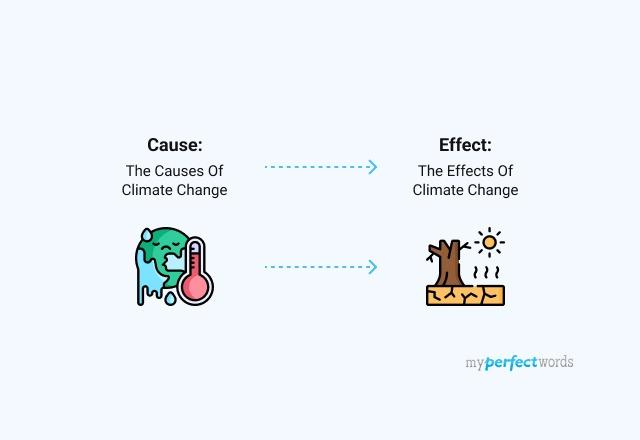
People also read
How To Write A Cause and Effect Essay - Outline & Examples
230+ Cause and Effect Essay Topics to Boost Your Academic Writing
How to Create a Cause and Effect Outline - An Easy Guide
You need to write a cause and effect essay for your assignment. Well, where should you start?
Establishing a relationship between causes and effects is no simple task. You need to ensure logical connections between variables with credible evidence.
However, don't get overwhelmed by the sound of it. You can start by reading some great cause and effect essay examples.
In this blog, you can read cause and effect essays to get inspiration and learn how to write them. With these resources, you'll be able to start writing an awesome cause and effect paper.
Let’s dive in!
- 1. What is a Cause and Effect Essay?
- 2. Cause and Effect Essay Examples for Students
- 3. Free Cause and Effect Essay Samples
- 4. Cause and Effect Essay Topics
- 5. Tips For Writing a Good Cause and Effect Essay
What is a Cause and Effect Essay?
A cause and effect essay explores why things happen (causes) and what happens as a result (effects). This type of essay aims to uncover the connections between events, actions, or phenomena. It helps readers understand the reasons behind certain outcomes.
In a cause and effect essay, you typically:
- Identify the Cause: Explain the event or action that initiates a chain of events. This is the "cause."
- Discuss the Effect: Describe the consequences or outcomes resulting from the cause.
- Analyze the Relationship: Clarify how the cause leads to the effect, showing the cause-and-effect link.
Cause and effect essays are common in various academic disciplines. For instance, studies in sciences, history, and the social sciences rely on essential cause and effect questions. For instance, "what are the effects of climate change?", or "what are the causes of poverty?"
Now that you know what a cause and effect is, let’s read some examples.
Cause and Effect Essay Examples for Students
Here is an example of a well-written cause and effect essay on social media. Let’s analyze it in parts to learn why it is good and how you can write an effective essay yourself.
Do you know that the average person now spends over two hours a day on social media platforms? Social media has become an integral part of our daily lives. Whether it's Facebook, Instagram, or Twitter, these platforms have revolutionized the way we connect, communicate, and share our experiences with the world. However, while they offer many advantages, the excessive use of social media can have detrimental effects on our mental health. In this essay, we will explore the causes and effects of this relationship, shedding light on the profound influence social media has on our well-being. |
The essay begins with a compelling hook that grabs the reader's attention. It presents a brief overview of the topic clearly and concisely. The introduction covers the issue and ends with a strong thesis statement , stating the essay's main argument – that excessive use of social media can negatively impact mental health.
The rise of social media has led to an unprecedented increase in screen time. According to recent statistics, the average person spends over two hours per day on social media platforms. This surge is largely due to the addictive nature of these platforms, which are designed to keep us engaged. Endless scrolling, constant notifications, and the desire for likes and comments contribute to a compulsive need to check social media. This excessive use of social media is the first point to examine. |
The first body paragraph sets the stage by discussing the first cause - excessive social media use. It provides data and statistics to support the claim, which makes the argument more compelling. The analysis highlights the addictive nature of social media and its impact on users. This clear and evidence-based explanation prepares the reader for the cause-and-effect relationship to be discussed.
As social media usage has surged, so too has the number of people reporting symptoms of anxiety and depression. Studies have shown a significant correlation between the time spent on social media and the likelihood of experiencing these mental health issues. Constant exposure to carefully curated, idealized representations of others' lives can lead to unfavorable social comparisons. We start to measure our worth by the number of likes and followers we have, and we often fall short, which leads to anxiety and depression. |
The second body paragraph effectively explores the effect of excessive social media use, which is increased anxiety and depression. It provides a clear cause-and-effect relationship, with studies backing the claims. The paragraph is well-structured and uses relatable examples, making the argument more persuasive.
A second cause of the negative impact of social media on mental health is the phenomenon of social comparison. When we scroll through our feeds and see our friends and acquaintances posting photos of their exotic vacations, happy relationships, and personal achievements, we can't help but compare our own lives. The fear of missing out (FOMO) is a real and growing concern in today's digital age. We are constantly bombarded with images and stories that make us feel like we are missing out on the excitement and fulfillment that others seem to be experiencing. |
The third body paragraph effectively introduces the second cause, which is social comparison and FOMO. It explains the concept clearly and provides relatable examples. It points out the relevance of this cause in the context of social media's impact on mental health, preparing the reader for the subsequent effect to be discussed.
Social comparison and FOMO have tangible effects on our mental health. People who engage in these comparisons often feel isolated and alone. The constant exposure to others' seemingly perfect lives can lead to a sense of inadequacy and decreased self-esteem. We start to question our own choices and accomplishments, believing that we are falling short in comparison to our peers. |
The fourth body paragraph effectively explores the second effect of social comparison and FOMO, which is isolation and decreased self-esteem. It provides real-world consequences and uses relatable examples.
In conclusion, the impact of social media on our mental health is undeniable. The excessive use of social media leads to increased anxiety, depression, and feelings of inadequacy, while the fear of missing out amplifies these negative emotions. It's crucial to acknowledge these challenges and their effect on our well-being. As we navigate this ever-evolving digital landscape, finding a healthier balance in the digital age becomes essential. We must consider limiting our social media use, curating our online experiences, and promoting digital detox. By taking these steps, we can protect our mental health and ensure that the benefits of social media are enjoyed without the accompanying harm. |
The conclusion effectively summarizes the key points discussed in the essay. It restates the thesis statement and offers practical solutions, demonstrating a well-rounded understanding of the topic. The analysis emphasizes the significance of the conclusion in leaving the reader with a call to action or reflection on the essay's central theme.
This essay follows this clear cause and effect essay structure to convey the message effectively:
Read our cause and effect essay outline blog to learn more about how to structure your cause and effect essay effectively.

Free Cause and Effect Essay Samples
The analysis of the essay above is a good start to understanding how the paragraphs in a cause and effect essay are structured. You can read and analyze more examples below to improve your understanding.
Cause and Effect Essay Elementary School
Cause and Effect Essay For College Students
Short Cause and Effect Essay Sample
Cause and Effect Essay Example for High School
Cause And Effect Essay IELTS
Bullying Cause and Effect Essay Example
Cause and Effect Essay Smoking
Cause and Effect Essay Topics
Wondering which topic to write your essay on? Here is a list of cause and effect essay topic ideas to help you out.
- The Effects of Social Media on Real Social Networks
- The Causes And Effects of Cyberbullying
- The Causes And Effects of Global Warming
- The Causes And Effects of WW2
- The Causes And Effects of Racism
- The Causes And Effects of Homelessness
- The Causes and Effects of Parental Divorce on Children.
- The Causes and Effects of Drug Addiction
- The Impact of Technology on Education
- The Causes and Consequences of Income Inequality
Need more topics? Check out our list of 150+ cause and effect essay topics to get more interesting ideas.
Tips For Writing a Good Cause and Effect Essay
Reading and following the examples above can help you write a good essay. However, you can make your essay even better by following these tips.
- Choose a Clear and Manageable Topic: Select a topic that you can explore thoroughly within the essay's word limit. A narrowly defined topic will make it easier to establish cause-and-effect relationships.
- Research and Gather Evidence: Gather relevant data, statistics, examples, and expert opinions to support your arguments. Strong evidence enhances the credibility of your essay.
- Outline Your Essay: Create a structured outline that outlines the introduction, body paragraphs, and conclusion. This will provide a clear roadmap for your essay and help you present causes and effects clearly and coherently.
- Transitional Phrases: Use transitional words and phrases like "because," "due to," "as a result," "consequently," and "therefore" to connect causes and effects within your sentences and paragraphs.
- Support Each Point: Dedicate a separate paragraph to each cause and effect. Provide in-depth explanations, examples, and evidence for each point.
- Proofread and Edit: After completing the initial draft, carefully proofread your essay for grammar, punctuation, and spelling errors. Additionally, review the content for clarity, coherence, and flow.
- Peer Review: Seek feedback from a peer or someone familiar with the topic to gain an outside perspective. They can help identify any areas that need improvement.
- Stay Focused: Avoid going off-topic or including irrelevant information. Stick to the causes and effects you've outlined in your thesis statement.
- Revise as Needed: Don't hesitate to make revisions and improvements as needed. The process of revising and refining your essay is essential for producing a high-quality final product.
To Sum Up ,
Cause and effect essays are important for comprehending the intricate relationships that shape our world. With the help of the examples and tips above, you can confidently get started on your essay.
If you still need further help, you can hire a professional writer to help you out. At MyPerfectWords.com , we’ve got experienced and qualified essay writers who can help you write an excellent essay on any topic and for all academic levels.
Simply say ' help me do my essay ' and we will provide the professional support you need to get a well-written essay.

Write Essay Within 60 Seconds!

Caleb S. has been providing writing services for over five years and has a Masters degree from Oxford University. He is an expert in his craft and takes great pride in helping students achieve their academic goals. Caleb is a dedicated professional who always puts his clients first.

Paper Due? Why Suffer? That’s our Job!
Keep reading
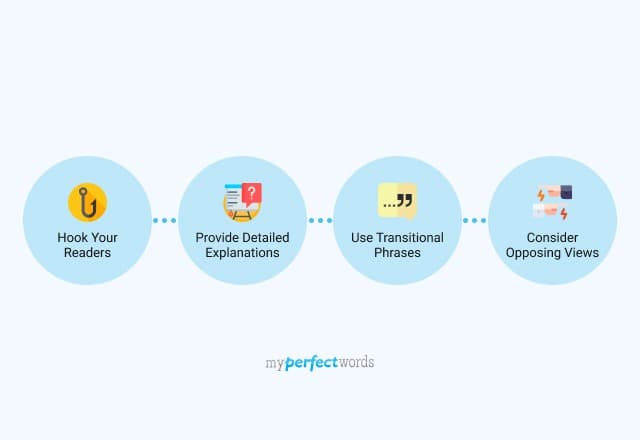

Want to create or adapt books like this? Learn more about how Pressbooks supports open publishing practices.
15.9 Cause-and-Effect Essay
Learning objective.
- Read an example of the cause-and-effect rhetorical mode.
Effects of Video Game Addiction
Video game addition is a serious problem in many parts of the world today and deserves more attention. It is no secret that children and adults in many countries throughout the world, including Japan, China, and the United States, play video games every day. Most players are able to limit their usage in ways that do not interfere with their daily lives, but many others have developed an addiction to playing video games and suffer detrimental effects.
An addiction can be described in several ways, but generally speaking, addictions involve unhealthy attractions to substances or activities that ultimately disrupt the ability of a person to keep up with regular daily responsibilities. Video game addiction typically involves playing games uncontrollably for many hours at a time—some people will play only four hours at a time while others cannot stop for over twenty-four hours. Regardless of the severity of the addiction, many of the same effects will be experienced by all.
One common effect of video game addiction is isolation and withdrawal from social experiences. Video game players often hide in their homes or in Internet cafés for days at a time—only reemerging for the most pressing tasks and necessities. The effect of this isolation can lead to a breakdown of communication skills and often a loss in socialization. While it is true that many games, especially massive multiplayer online games, involve a very real form of e-based communication and coordination with others, and these virtual interactions often result in real communities that can be healthy for the players, these communities and forms of communication rarely translate to the types of valuable social interaction that humans need to maintain typical social functioning. As a result, the social networking in these online games often gives the users the impression that they are interacting socially, while their true social lives and personal relations may suffer.
Another unfortunate product of the isolation that often accompanies video game addiction is the disruption of the user’s career. While many players manage to enjoy video games and still hold their jobs without problems, others experience challenges at their workplace. Some may only experience warnings or demerits as a result of poorer performance, or others may end up losing their jobs altogether. Playing video games for extended periods of time often involves sleep deprivation, and this tends to carry over to the workplace, reducing production and causing habitual tardiness.
Video game addiction may result in a decline in overall health and hygiene. Players who interact with video games for such significant amounts of time can go an entire day without eating and even longer without basic hygiene tasks, such as using the restroom or bathing. The effects of this behavior pose significant danger to their overall health.
The causes of video game addiction are complex and can vary greatly, but the effects have the potential to be severe. Playing video games can and should be a fun activity for all to enjoy. But just like everything else, the amount of time one spends playing video games needs to be balanced with personal and social responsibilities.
Online Cause-and-Effective Essay Alternatives
Lawrence Otis Graham examines racism, and whether it has changed since the 1970s, in The “Black Table” Is Still There :
- http://scremeens.googlepages.com/TheBlackTableessay.rtf
Robin Tolmach Lakoff discusses the power of language to dehumanize in From Ancient Greece to Iraq: The Power of Words in Wartime :
- http://www.nytimes.com/2004/05/18/science/essay-from-ancient-greece-to-iraq-the-power-of-words-in-wartime.html
Alan Weisman examines the human impact on the planet and its effects in Earth without People :
- http://discovermagazine.com/2005/feb/earth-without-people
Writing for Success Copyright © 2015 by University of Minnesota is licensed under a Creative Commons Attribution-NonCommercial-ShareAlike 4.0 International License , except where otherwise noted.
- Grades 6-12
- School Leaders
Get 50% off your first box of Home Chef! 🥙
137 Intriguing Cause & Effect Essay Topics for Students
Teach critical thinking, logic, and the art of persuasion.
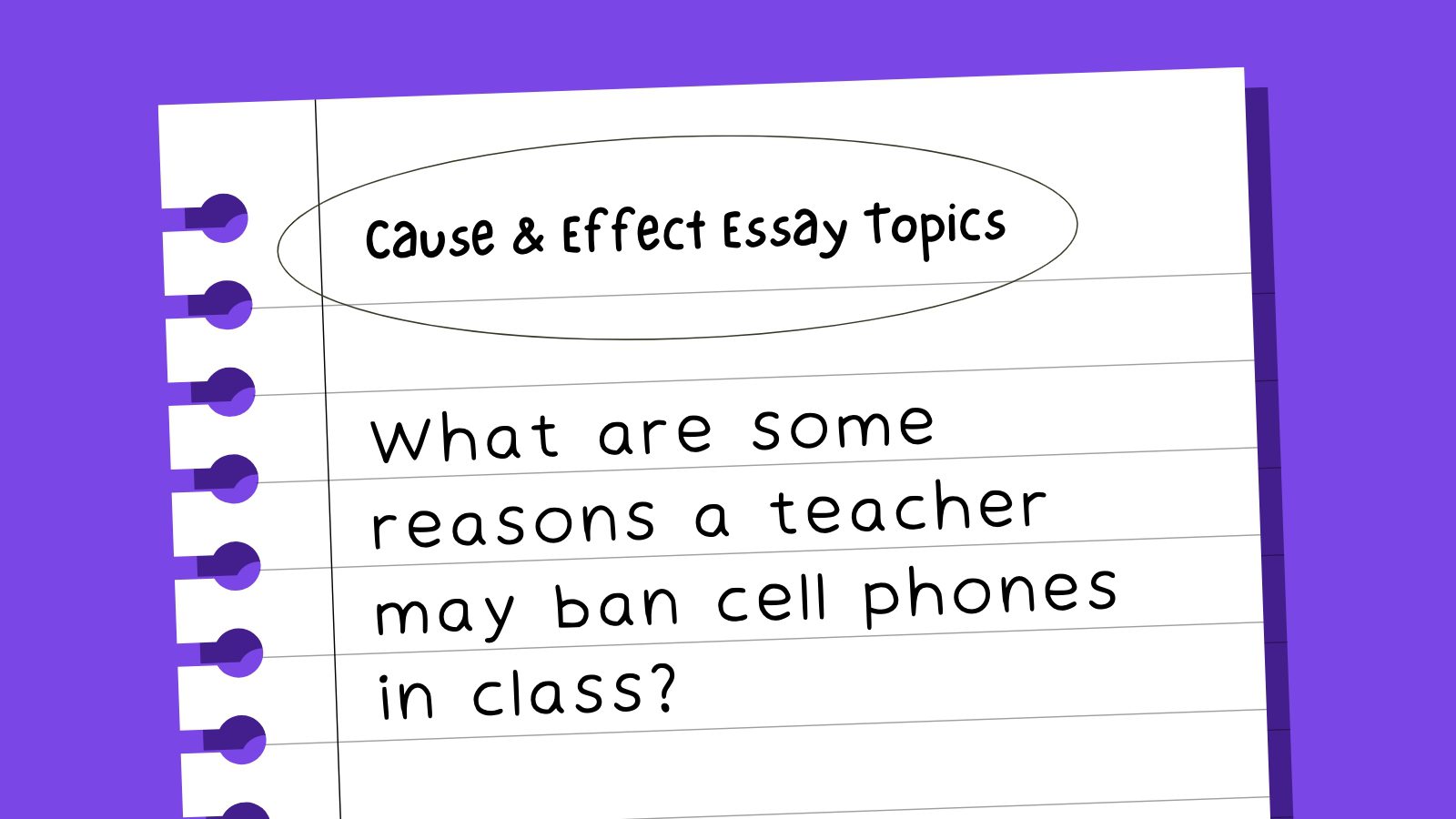
Cause-and-effect essays aren’t just a way to help students strengthen their writing skills. They’ll also learn critical thinking, logic, and the art of persuasion. In addition, they teach students to demonstrate how one thing directly influences another. Coming up with engaging cause-and-effect essay topics can be challenging, but we have you covered. This list of ideas includes a variety of topics that range from social and cultural movements to mental health and the environment.
Science and Environment Cause & Effect Essay Topics
- Describe the effect of urbanization on the environment.
- What is the impact of air pollution on health?
- What are the causes and consequences of plastics on marine life?
- What is the impact of rising sea temperatures on fish and marine life?
- Describe the impact of human behavior on global warming.
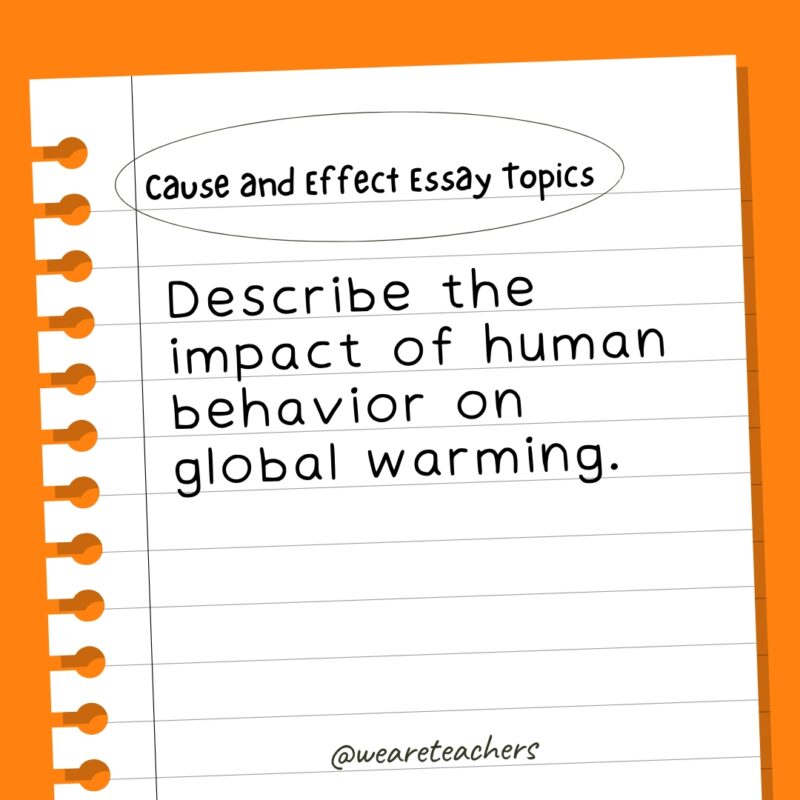
- What is the effect of social media on environmentalism?
- What causes volcanic eruptions?
- What causes trees to die?
- What are the effects of gravity?
- Why are plants green?
- Why do trees shed their leaves?
- What causes a species to become endangered?
- What are some of the causes of animals losing their habitats?
- Describe the effect of overpopulation on the environment.
- What are the effects of famine on human population?
- What are the causes and effects of Antarctica floods?
- What are the effects of pollution on the ocean?
- What effect do cars have on the environment?
- Why is it important to manage wildfires?
- What has been the impact of DNA on crime scene processing?
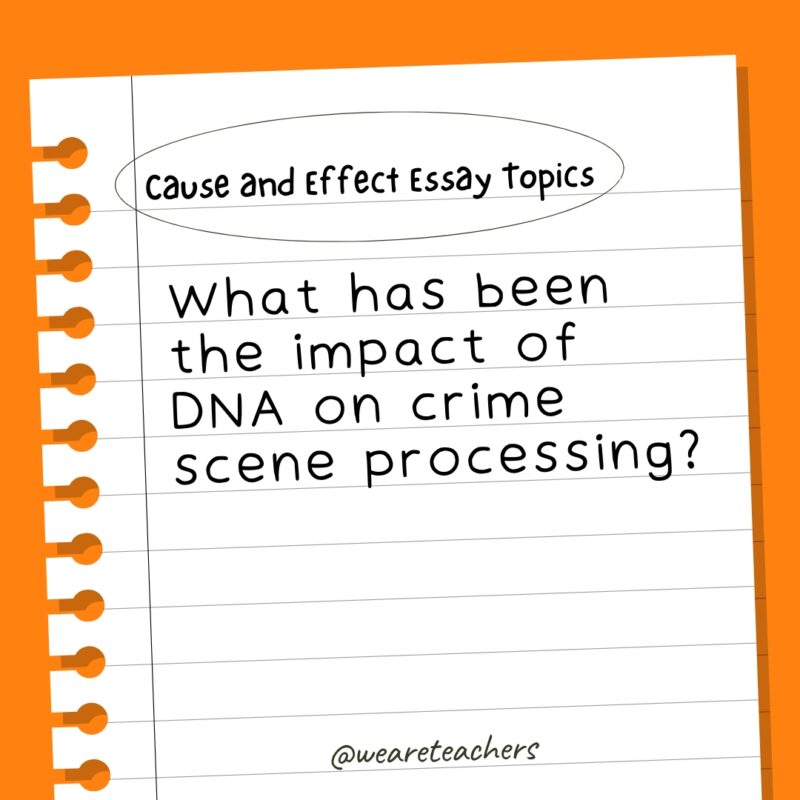
- What are the impacts of deforestation in Brazil?
- What are the effects of GMO foods on human health?
- What are the impacts of immunizations on human health?
Technology and Social Media Cause & Effect Essay Topics
- What are the effects of social media on adolescent development?
- How does technology affect productivity?
- What are the effects of video games on childhood development?
- How do cell phones affect human relationships?
- What are some reasons a teacher might ban cell phones from class?
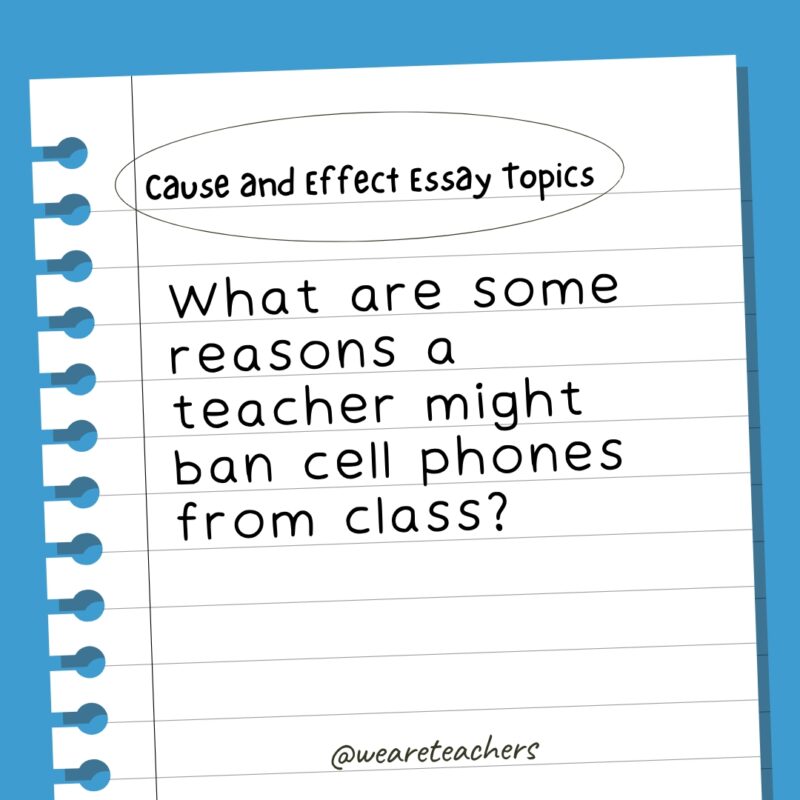
- What effects do cell phones have on sleep?
- What effects did the invention of the Internet have on technology?
- What were the origins of cyberbullying?
- What are the effects of tablet use on small children?
- How has online dating changed relationships?
- What makes some people less likely to use social media?
- What are the effects of social media on privacy?
- How does the rise of TikTok affect Facebook and Instagram?
- In what ways could social media lead to extremism?
- What is the impact of social media on the increasing popularity of plastic surgery and other enhancements?
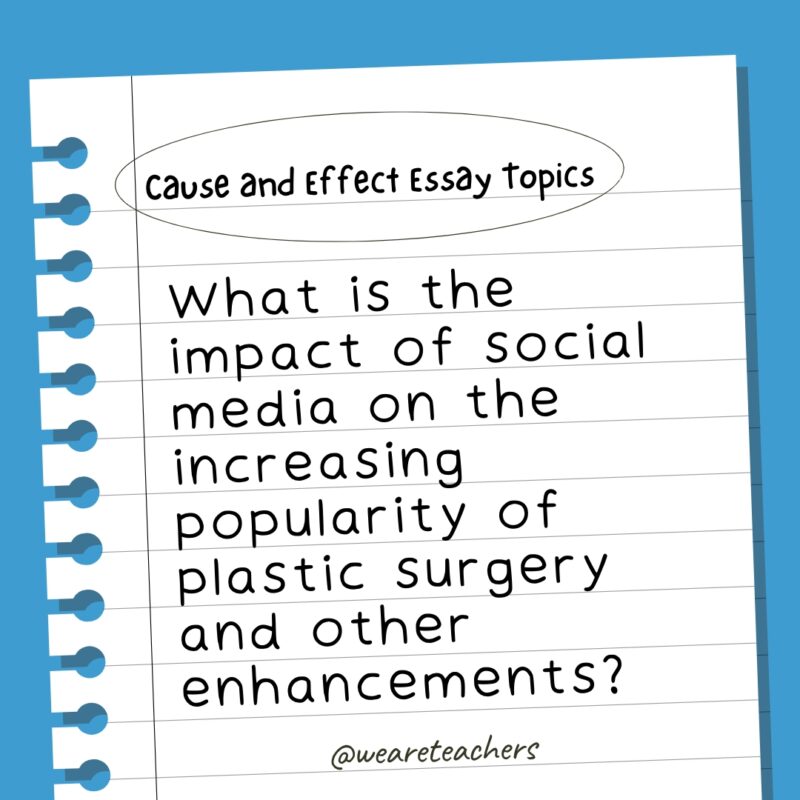
- What are some of the benefits of owning a smartphone and what are some of the drawbacks?
- What has been the impact of online shopping on brick-and-mortar stores?
- What has been the impact of smartphones on marriages and relationships?
- What are the causes and effects of texting while driving?
- What has the rise of “influencers” meant for Hollywood?
- In what ways have photo filters influenced young people’s self-esteem?
Culture and Social Issues Cause & Effect Essay Topics
- What are some of the reasons for substance abuse in young people?
- What are some of the effects of bullying?
- How does economic status affect the quality of health care?
- What are some of the causes of homelessness?
- Explain the effects of ignorance on discrimination.
- What are the impacts of death sentences on social justice?
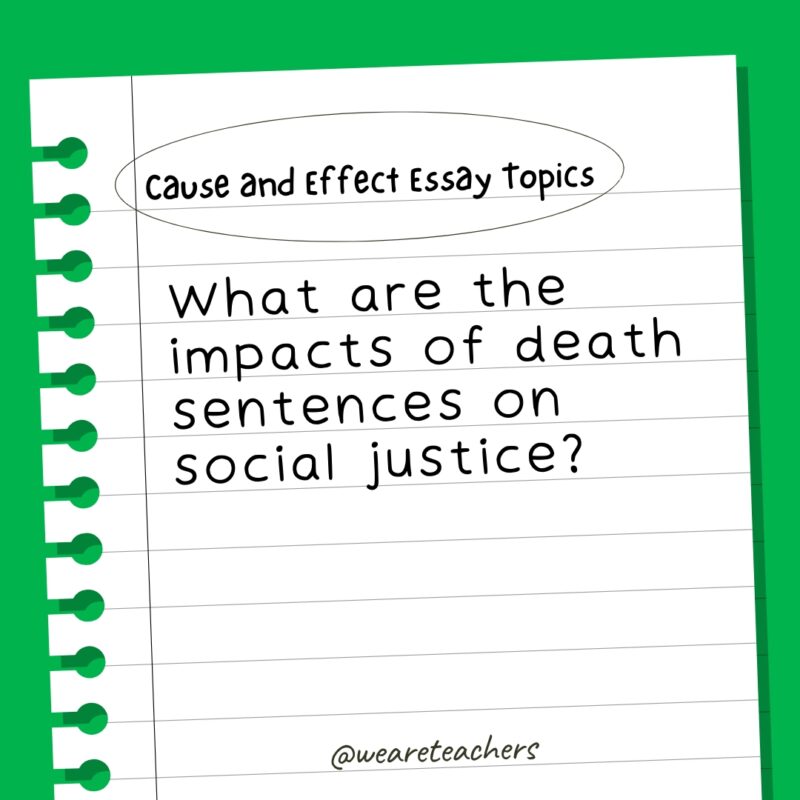
- How does financial success affect societal privilege?
- What effects does growing up poor have on children?
- In what ways does religion influence society?
- What are the effects of immigration on a host country?
- What are the effects of ageism on job opportunities?
- What is the impact of LGBTQ+ representation in TV and movies?
- What are the effects of school shootings on politics?
- How do school uniforms affect students?
- What are the impacts of high student debt?
- What are the impacts of body shaming on people?
- What were the lasting impacts of the AIDS epidemic on society?
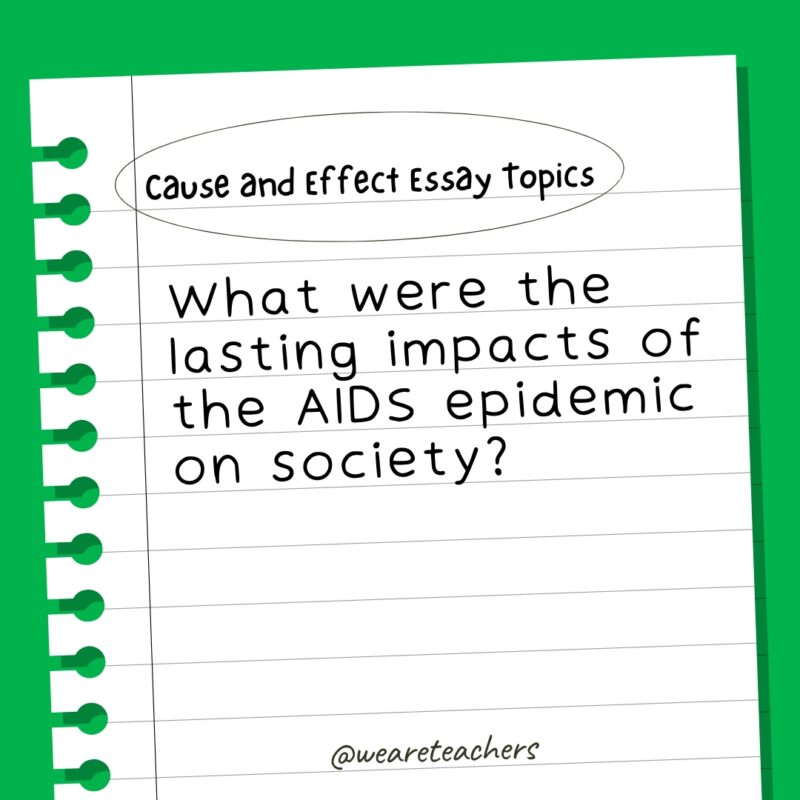
- What impact does banning abortion have in the United States?
- What has been the impact of marriage equality in the United States?
- What are the causes and effects of noise pollution?
- What are the causes and effects of inflation on the economy?
- What are the effects of TV shows on our behavior?
Sports Cause & Effect Essay Topics
- Examine the effects of exercise on mental health.
- What led to baseball being an iconic American sport?
- What drives people to participate in extreme sports?
- In what ways did globalization affect modern sports?
- What were the effects of doping on amateur and professional sports?
- Select a sport and write about the historical factors that led to the popularization of that sport.
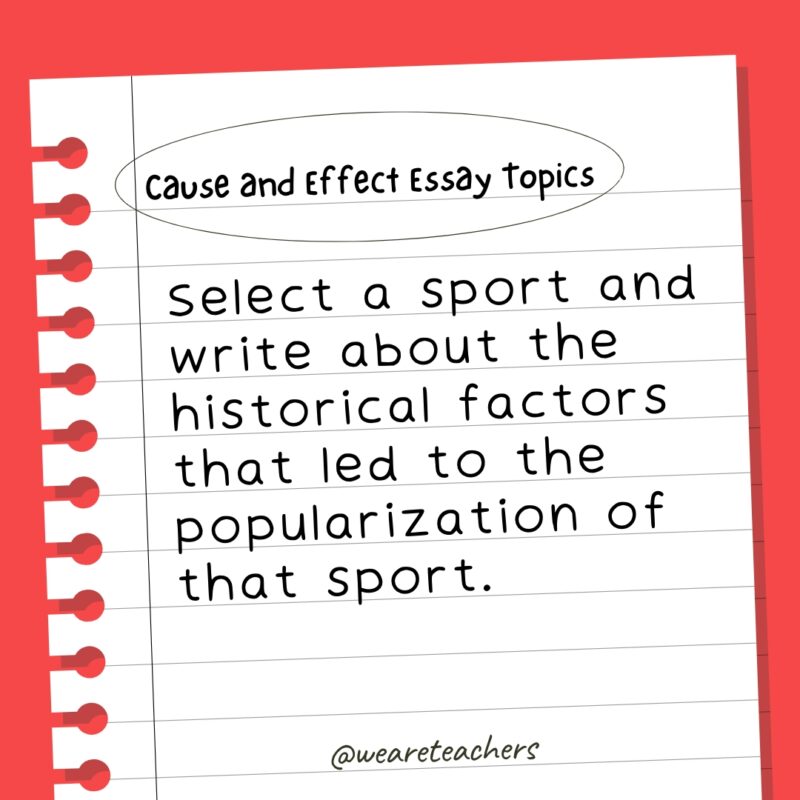
- Describe the ways in which youth sports influence a child’s development.
- What were the driving forces behind the first Olympics?
- How can team sports help develop social skills?
- How have e-sports changed the sporting landscape?
- In what ways do race biases influence sports?
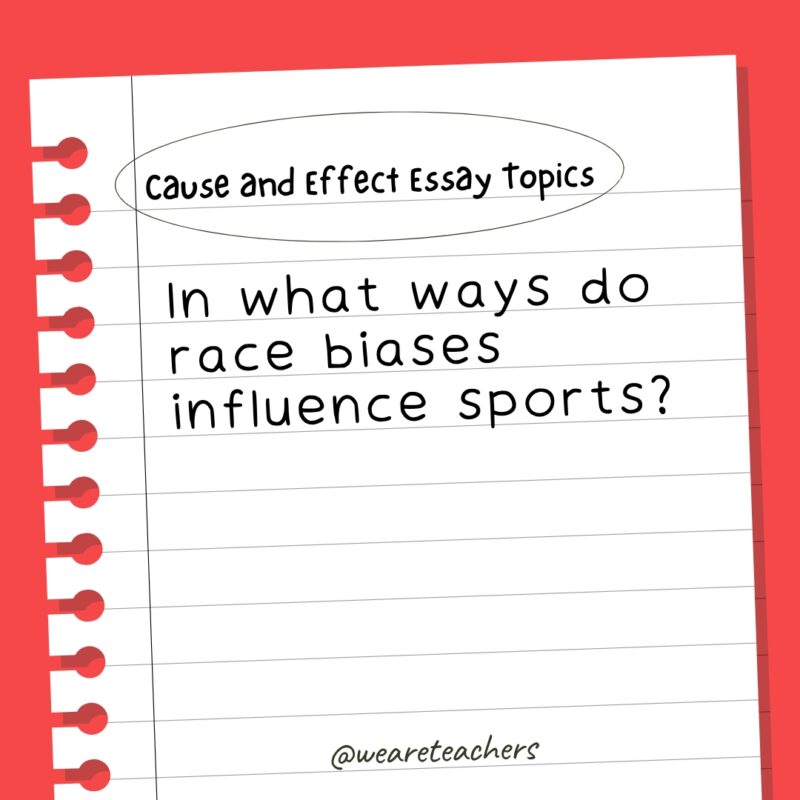
- What are the effects of regular workouts on immunity?
- How does participating in sports affect leadership skills?
- In what ways can sports lead to character development?
- What effect does famous athletes’ social commentary have on their fans?
History Cause & Effect Essay Topics
- What are the effects of the war in Syria on the United States?
- What have been the lasting effects of the Civil Rights Movement?
- What were the causes and effects of the attack on Pearl Harbor?
- What led up to the Berlin Wall being torn down and what effects did that have?
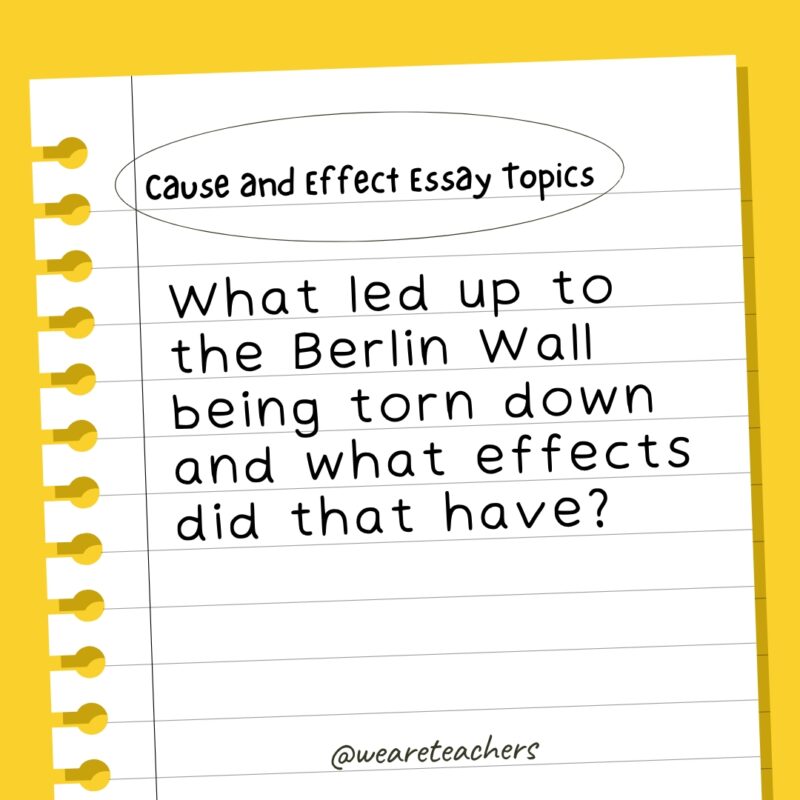
- What lasting impact did 9/11 have on modern American society?
- What were the causes of the Salem Witch Trials?
- What was the cultural impact of the Spanish-American War?
- How has globalization led to modern-day slavery?
- What events led to the fall of the Roman Empire?
- What were the impacts of the Great Depression on women’s employment?
- How did cartels come into existence? What effect have they had on the United States and Mexico?
- What were the causes and effects of the Women’s Liberation Movement?
- Give an example of colonialism in history and name the resulting impact to the affected society.
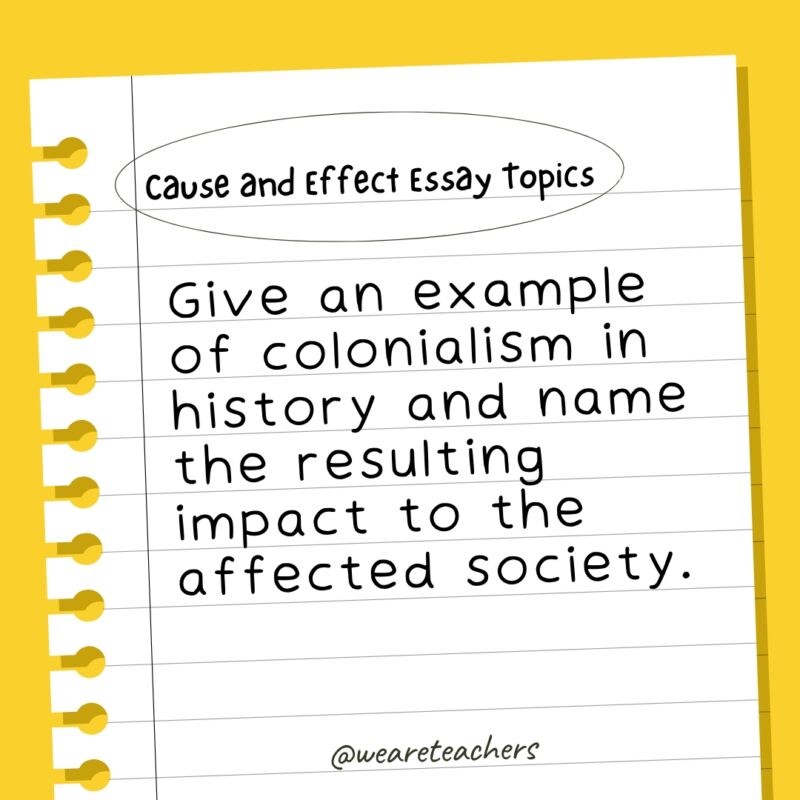
- What led to the rise of ISIS and what has the impact been on international security?
- What factors led to the Titanic’s sinking?
- What were the causes and effects of the Vietnam War?
- Choose an American president. What led him to become president and what were the effects of his presidency?
Mental Health Cause & Effect Essay Topics
- How can stress affect the immune system?
- How does social anxiety affect young people?
- How can high academic expectations lead to depression?
- What are the effects of divorce on young people?
- How does service in the armed forces lead to post-traumatic stress disorder?
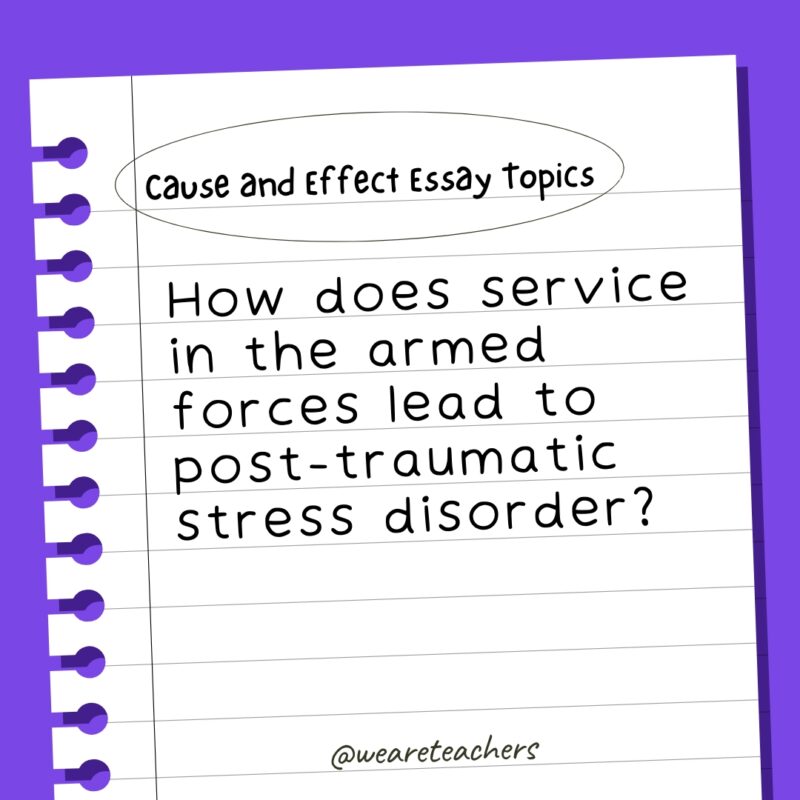
- What are the effects of mindfulness on mental health?
- Describe the ways in which the COVID-19 pandemic has impacted mental health.
- How does childhood trauma impact childhood development?
- What impact does witnessing violence have on mental health?
- What is behind increasingly high levels of anxiety in modern American society?
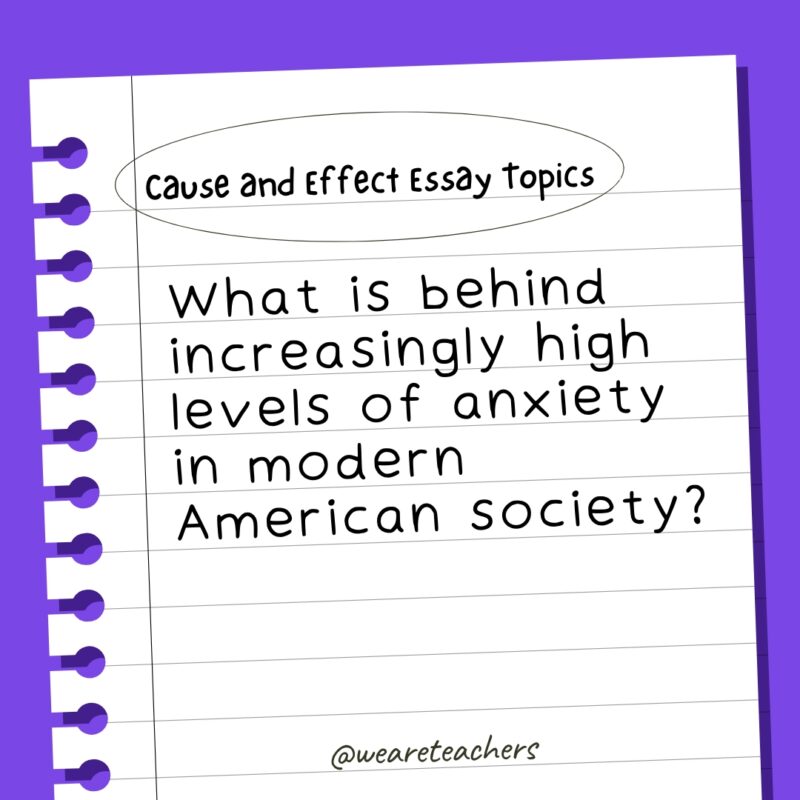
- What are the causes and effects of panic attacks?
- What are the causes and consequences of high stress in the workplace?
- What are some of the causes of insomnia and in what ways does it affect mental health?
- What is the impact of staying home for an extended period of time?
Current Events Cause & Effect Essay Topics
- Choose a local public education campaign. What are the effects of that campaign?
- What are the causes and effects of migration?
- What are the causes and effects of terrorist attacks?
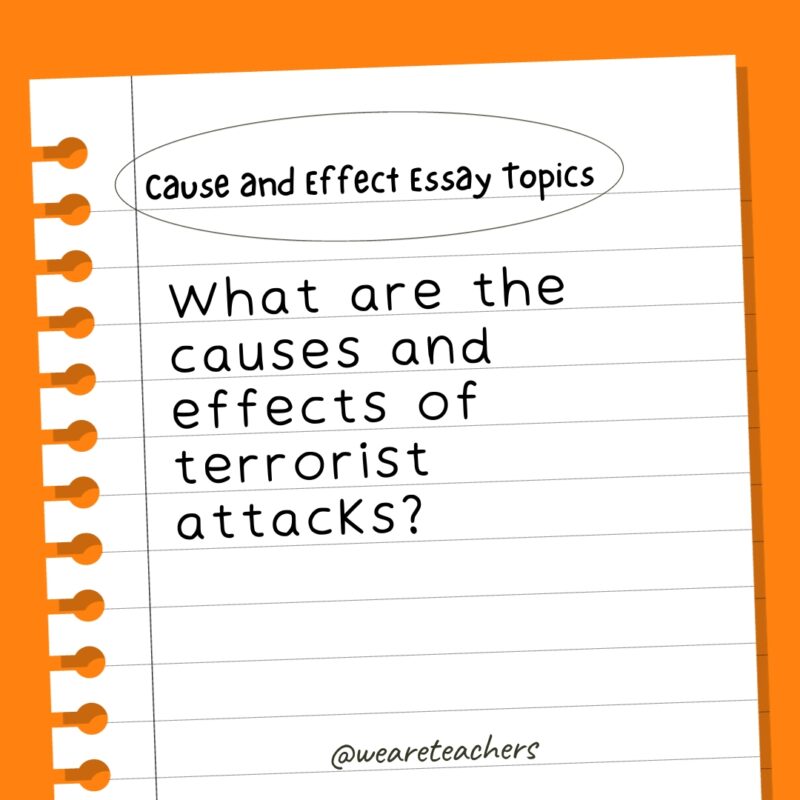
- What are the effects of legalizing genetic engineering research?
- How do low voting rates impact elections and government?
- What is the effect of raising the minimum wage?
- What are the effects of globalization on society?
- How does gerrymandering affect election outcomes?
- What are the causes and effects of police brutality?
- What are the causes and effects of political polarization?
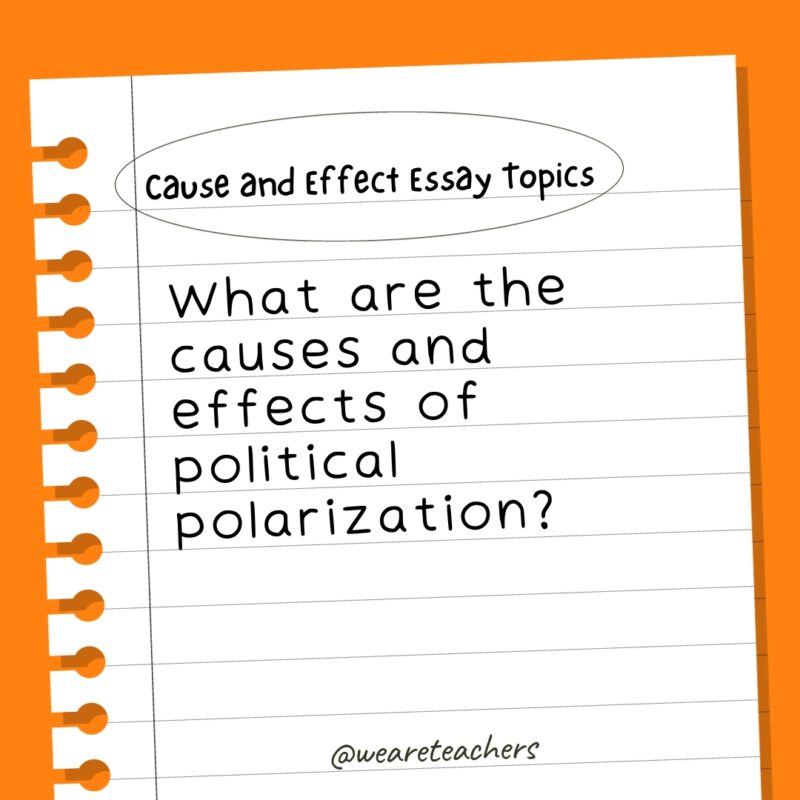
- What are the causes and effects of fake news?
- What are the effects of global war on citizens?
- What is the effect of international aid on poverty or health?
- Why do some countries have nuclear weapons, and what does this mean for other countries?
Education Cause & Effect Essay Topics
- What are the effects of teacher quality on student success?
- What are the causes and effects of student loan debt?
- What are the causes and effects of low graduation rates?
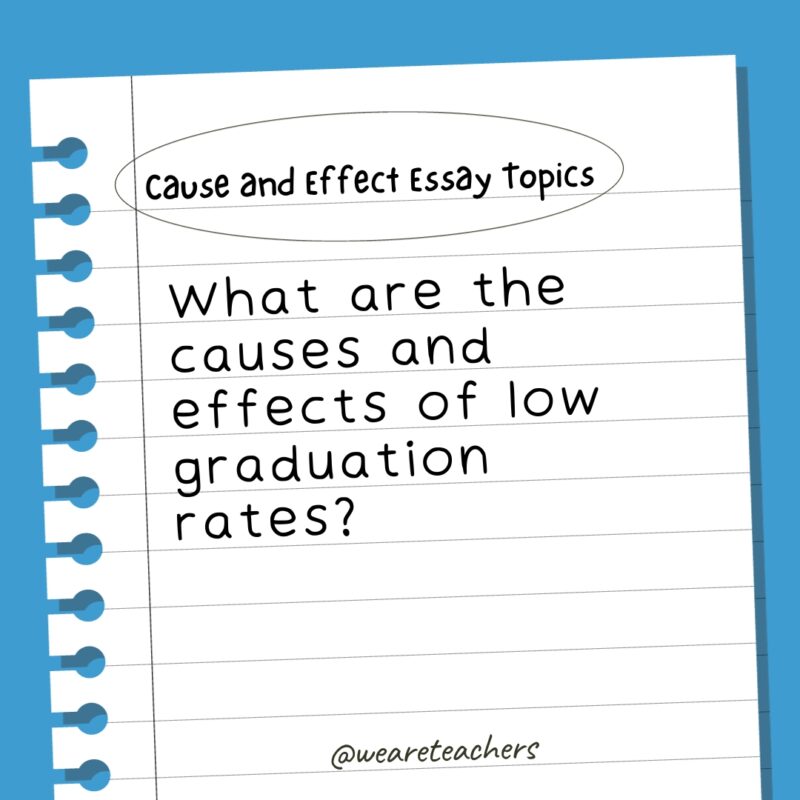
- What are the effects of assigning homework?
- What are the causes and effects of school funding disparities?
- What are the causes and effects of the digital divide in education?
- What is the effect of AI on education?
- What are the causes and effects of student burnout?
- Should students be required to study a foreign language in school, and what are the effects of learning a foreign language?

- What effect has the COVID pandemic had on education?
- What are the effects of same-sex classrooms or schools?
What are your best cause-and-effect essay topics for students? Come exchange ideas in the We Are Teachers HELPLINE group on Facebook.
Plus, check out our list of interesting persuasive essay topics for kids and teens..
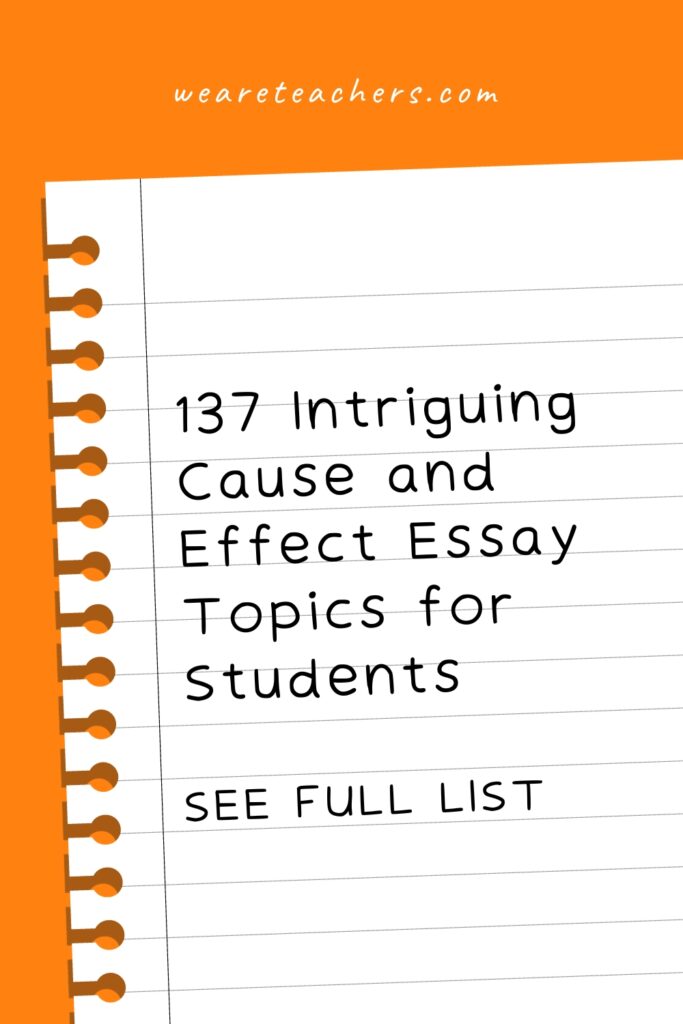
You Might Also Like
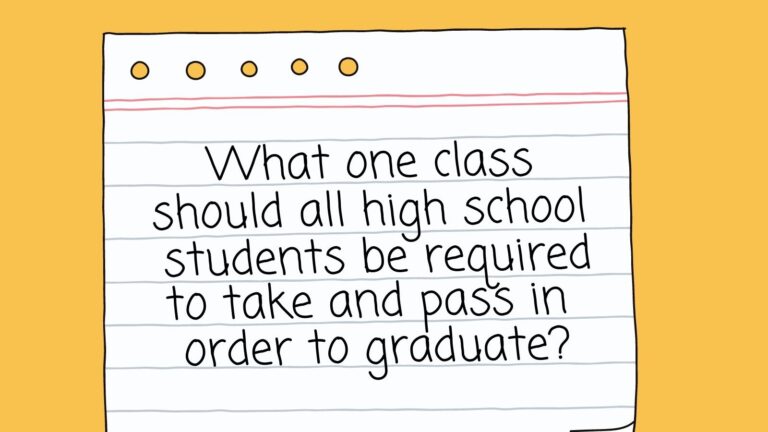
The Big List of Essay Topics for High School (150+ Ideas!)
Ideas to inspire every young writer! Continue Reading
Copyright © 2024. All rights reserved. 5335 Gate Parkway, Jacksonville, FL 32256
Encyclopedia for Writers
Writing with ai, causes & effects.
- © 2023 by Joseph M. Moxley - Founder, Writing Commons
Learn to explore your causal relationships. Improve your critical thinking skills.
Table of Contents
- “Why are things like this?
- What is the effect, or result, of this?” and “
- What causes this?”
These questions guide authors as they analyze or argue about causal relationships, such as “What is the effect of a college education on income?”
Unlike explanations of processes, which follow a chronological order of events, cause and effect texts are deeply speculative and tentative, relying on causal reasoning and argument. Your purpose is to answer
- Why are things like this?
- What is the effect, or result, of this?
- What is the cause of this?
Analyzing cause-and-effect relationships requires you to question how different parts and sequences interact with each other over time, which is often more difficult than reporting a chronological order of events, as you do when describing a process.
Why Write About Causes and Effects?
Human beings ask why perhaps more than any other question. When we listen to the nightly news and hear about the atrocities of war, we wonder, “What causes the hatred?” When we read about the violence plaguing our country, we ask, “Why does the United States lead the world in violent crimes?” When we read studies that indicate that 28 percent of women in America have been raped and that the occurrence of date rape is rising on college campuses, we ask, “Why is this happening?” When we read about environmental problems such as the depletion of the ozone layer, we wonder, “Why don’t we do something about it?” Whenever we make decisions in our daily lives, we ask ourselves, “Why should I do this?”
On a daily basis, we seek to understand why events occurred by identifying the factors that led up to them. For example, if you were not doing well in school and on homework assignments, you might ask, “Did my high school class(es) sufficiently prepare me for this class? Am I studying long enough? Am I taking effective lecture notes? Am I paying too much attention to the course texts and too little to the instructor’s lectures? How is my attendance? Is my part-time job interfering too much with my school work? Am I using my time to study effectively? Are some of my friends having a negative influence on my study habits? Am I taking too many courses or putting too much time into another course? What can I do to improve my memory or study skills?” After asking these and other questions, you would eventually be able to identify a variety of causes for your poor performance, and once you recognize the causal relationship, you can set about realistically to improve your grade.
Cause-and-effect assignments are among the most interesting writing projects that you will tackle in school and in professional life. In school, teachers frequently assign process assignments. For example, humanities professors may ask for an analysis of what causes particular music genres or artistic genres to capture the imagination of popular culture; history professors, the impact of cultures on world history; social science professors, the effects of inventions on culture or the effect of gun control laws on violent homicide rates; business professors, the effects of changes in the interest rates on the economy.
Cause-and-effect texts are extremely common in professions–particularly the sciences, where researchers employ the scientific method to seek out cause-and-effect relationships. Writers commonly focus on analyzing causes or effects. A medical writer, for example, might explore the effects of a poor diet or the causes of a disease. A lawyer might argue the effect of an accident on his client. A sports writer might analyze why a team continues its losing or winning streak.
Diverse Rhetorical Situations
The purpose of many cause-and-effect texts is to explain the effects or causes of something. And the tone of these texts tends to be dispassionate and objective. In complex situations, however, the writer’s purpose may shift from explaining to speculating or even arguing about an interpretation. Sometimes writers argue about a particular cause or effect because they want to sell you something or because they want to change your mind on a policy or interpretation.
People write about causes and effects for a variety of communication situations, and they employ a variety of media. The shape and content of cause-and-effect reports tend to be more diverse than the shape and content of texts that explain subjects, concepts, or processes, as suggested in the table below.
| Purposes | Audiences | Voices | Genre & Media |
Rhetorical Analysis of Cause and Effect Texts
Consider the context, audience, purpose, and media invoked by the following readings. Also examine how ideas are developed in these texts. Are assertions grounded in personal experience, interviews with authorities, questionnaires, Internet and library research, or empirical research?
- GHB on Campus : A subtext of a larger Web site created to educate readers about the dangers of GHB, this page summarizes the deadly effects of GHB on college campuses and urges readers to forward a listserv message to their friends, which reveals the deadly effects of GHB. Interestingly, a sidebar seeks readers’ input to a survey on GHB usage on college campuses. On the Project GHB home page, the authors explain that Mr. and Mrs. Shortridges began the site following the death of their son to a GHB overdose: This GHB website started out as a quick project with the sole purpose of getting some truth about GHB on the Internet. In doing their original searches for GHB on the Internet, the Shortridges found that most websites advocate its use, etc. Some Internet pages about GHB have seemingly educated reports about GHB. They offer recipes, kits for sale, and tips for “safe” experiences.
- College graduation rate below 50 percent : Written by a reporter for CNN.com, this texts summarizes academic research conducted by the Council for Aid to Education. The research analyzed why 52 percent of students in public colleges and 45 percent of students in private colleges failed to graduate in 2000. The researcher focused on greater access to college as the cause for the high dropout rate, suggesting that students who are being accepted into college are not prepared and that colleges need to do more to help these students succeed. The author’s tone/voice is impersonal and objective. The audience for the original research study was universities, while this report is written for a broader audience–readers of CNN’s online education pages.
- The Mayo Clinic discusses the causes of HIV infection, and symptoms experienced after HIV infection, to provide initial information to individuals with little education on HIV/AIDS.
- The State of the World’s Children by UNICEF : Mixing evocative pictures with extremely detailed analyses of the effects of poor nutrition on the world’s children, UNICEF offers an informative and persuasive account of how countries and communities can and should help their children.
- The Dead Grandmother/Exam Syndrome and the Potential Downfall of American Society by Mike Adams : Written for a university audience, Mike Adams pokes fun at social science methods and students’ “grandmother” problems: Overall, a student who is failing a class and has a final coming up is more than 50 times more likely to lose a family member than an A student not facing any exams.
When dealing with causes and effects, it is important to keep to a narrow topic. Time constraints and resources should always be kept in mind when pursuing a topic. Example: To find the reasons for world hunger would take years of research and/or tons of hours, so focus on a specific entity of a broad topic. Perhaps you could identify one country’s efforts over the past few years.
Writers often bring focus to their work by claiming cause-and-effect relationships upfront, in their introductions. These “thesis statements” guide the writer and reader throughout the document. And they also offer clues as to the writer’s voice, tone, and persona. Consider, for example, this tongue-in-cheek analysis of the The Dead Grandmother/Exam Syndrome and the Potential Downfall Of American Society.
The basic problem can be stated very simply: A student’s grandmother is far more likely to die suddenly just before the student takes an exam, than at any other time of year.
While this idea has long been a matter of conjecture or merely a part of the folklore of college teaching, I can now confirm that the phenomenon is real. For over twenty years I have collected data on this supposed relationship, and have not only confirmed what most faculty had suspected, but also found some additional aspects of this process that are of potential importance to the future of the country. The results presented in this report provide a chilling picture and should waken the profession and the general public to a serious health and sociological problem before it is too late.
Development
Critical readers such as your instructors are quick to recognize shallow reasoning. College instructors expect you to cite multiple causes or effects when you are addressing a complex phenomenon. For example, if you were exploring the effects of TV on children, your readers would most likely expect you to do more than attack the violence as being unethical or immoral. Likewise, if you were analyzing the causes of our nation’s high divorce rates, your instructors would expect you to do more than cite troubles with finances as the cause of divorces.
To help you develop a stronger sense of the level of detail your readers need to understand a particular cause-and-effect relationship, consider conducting research. What have others reported about the particular cause-and-effect relationship you are exploring? Read about what others have speculated or reported about your topic.
Below are some additional suggestions for developing your cause-and-effect report.
Check for Post Hoc Fallacies
Critical readers will expect you to develop the reasoning that demonstrates the cause and effect relationship isn’t due to chance. Academic readers are reluctant to assume causality between two actions because they are trained to identify post hoc (“after this”) fallacies. Essentially a post hoc fallacy occurs when an author assumes Event B was caused by Event A simply because it followed Event A; the connection is false because it is equally possible that Event B was caused by some other factor. For example, let us suppose that Bill has been jilted by his girlfriend Laura. Because Laura argued with Bill last Friday night that he never spent any money on her and that she always has to pay for their dates, Bill might assume that she left him because he was cheap. However, this might not be the true reason for Laura’s dumping Bill. In fact, it could be that Laura was tired of Bill’s negative view of life. Perhaps she truly left Bill because she found him to be insensitive, boring, and uncommunicative.
Identify Sufficient and Necessary Causes
In some instances you may be able to explain an effect by identifying sufficient causes and necessary causes.
A sufficient cause is one that can cause the effect to take place. By itself, a sufficient cause can explain a phenomenon or trend. For instance, according to the Mayo Clinic resource above, in order for someone to contract the HIV virus, any of the following forms of contact is a sufficient cause:
- Blood transfusions
- Sharing needles
- Pregnancy, delivery, or breastfeeding
However, frequently more than one sufficient cause is necessary to explain a phenomenon or trend. Three or four causes, for example, may be necessary to explain an effect. You cannot say, for example, that all one needs is a match to start a fire. You also need oxygen and something to burn. When describing physical phenomena such as how acid rain is produced, you may have little difficulty identifying sufficient causes. Explaining human behavior is rarely so simple, of course.
Identify Remote/Speculative Causes
When we face complicated questions and problems, we often are unable to identify sufficient causes so we must speculate about necessary causes—those causes that can result in the effect. For instance, no single cause precipitated the collapse of the Soviet Union, yet we could speculate that hunger, poor economic conditions, alienation from communism, and political corruption were all remote causes.
Because academic readers are sensitive to the complexity of most issues, they generally do not expect you to offer sufficient causes for complex problems. Instead, they expect you to speculate about possible causes and effects, while limiting the scope of your claims with qualifiers such as “usually,” “may,” “possible,” “sometimes” or “most.” No simple answer, no sufficient cause, can explain, for example, why some people become violent criminals or serial killers while others devote themselves to feeding the hungry or serving the helpless.
Establish an Appropriate Voice
You can choose from a range of tones, personas and voices. Some writers choose a contentious, argumentative tone. Alternatively, sometimes writers will soften their tone, perhaps assuming a milder persona than they actually feel, because they fear providing the information in a more straightforward, argumentative way would cause readers to look elsewhere. For example, in Tropical Forests and Climate Change, the Canadian Development Agency offers a terrifying, well-researched analysis of global warming, yet softens its message with this caveat in the introduction:
Climate change predictions are difficult because of the complexity of the atmosphere and the interaction of the many variables involved.
Humanize Abstract Issues
No matter how technical your subject is, you should keep in mind that you are writing to other people. When you sense that the human story is being lost in abstract figures or academic jargon, consider adding an anecdote of how the problem you are discussing affects particular people. For example, Melissa Henderson, a student writer, began her report on the effect of crack on babies with the following portrayal of a newborn, which she composed after reading numerous essays about the effect of crack cocaine on human fetuses:
Lying restlessly under the warm lights like a McDonald’s Big Mac, Baby Doe fights with all of his three pounds of strength to stay alive. Because he was born prematurely, Baby Doe has an array of tubes and wires extending from his frail body which constantly monitor his heartbeat, drain excess fluid from his lungs and alert hospital personnel in the event he stops breathing. As he lies in the aseptic incubator his rigid little arms and legs twitch and jerk as though a steady current of electricity coursed through his veins. Suddenly, without warning or provocation, he begins to cry a mournful, inconsolable wail that continues steadily without an end in sight. As the nurses try to comfort the tiny infant with loving touches and soothing whispers, Baby Doe’s over-wrought nervous system can no longer cope. Suffering from sensory overload, he withdraws into the security offered in a long, deep slumber. Welcome to the world, Baby Doe, your mother is a crack cocaine addict.
As you write drafts of your causal report, consider incorporating an anecdote—that is, a brief story about how people are influenced by your subject. For example, if you are researching the effects of a sluggish economy on our nation’s poor, you might want to flesh out your statistics by depicting the story of how one homeless family lost their jobs, income, medical benefits, house, community, and hope.
Use Visuals
Although visuals are not required–in fact, many cause-and-effect texts do not use visuals–readers appreciate visuals, particularly ones that explain the cause-and-effect relationship being addressed. Consider, for example, this visual from the United States Environmental Protection Agency’s Web site on Global Warming:
Readers particularly appreciate tables and graphs. Critical readers will often skim through a document’s tables before reading the text:
Visuals can be used to influence readers at an emotional level. For example, at Project GHB’s Tragedy Page, each picture links to an obituary, which tells the personal story of how these young people overdosed on GHB
Organization
When analyzing causal relationships, you must reveal to readers how different parts and sequences interact with each other over time. Rather than merely reporting the order of events in chronological fashion as we do when describing a process, you need to identify the specific reasons behind the effects or causes. Your organization needs to reflect the logic of your analysis. This is often difficult because a single cause can result in many different effects. Likewise, an effect can have multiple causes.
For example, even a simple effect such as a minor car accident can have multiple causes. Yes, we could say that John D. caused the accident because he was driving while intoxicated. Yet if we knew more about John D.’s state of mind—if we knew, for instance, that he wasn’t watching where he was going because he was thinking about his wife’s threat to leave him—then we could identify additional causes for the accident. It could very well be that he was exhausted after a sleepless night. Or perhaps his personal predicament had nothing to do with the accident: Maybe the loss of his job that morning or his failure to have faulty brakes replaced is a more significant cause for the accident. If we get really carried away with our reasoning, we could say that his former employers were responsible. After all, John D. would not have lost his job if the automobile manufacturer he worked for had not closed three of its American plants and moved manufacturing of some parts to plants in Mexico, Hong Kong, and Japan. In addition, we could also find potential causes for the accident by considering the other driver, Susan K. Maybe she rushed into the busy intersection expecting everyone else to make room for her because she was already late for an in-class exam. Perhaps if Susan K. had not consumed four pots of coffee, she would have been more mellow, more cautious, and less willing to risk her life to get to school on time.
Use Formatting to Highlight Your Organization
You can emphasize the most emphatic elements of your analysis by using headings and subheadings. A quick scan of any of the cause-and-effect readings highlights the popularity of headings. For example, below are the headings used by the Canadian International Development Agency for their essay on Tropical Forests and Climate Change
- Is the world’s climate changing?
- How are we causing climate change?
- Impact of climate change on forests
- Climate change convention and the Kyoto protocol
- Forestry’s role in mitigating climate change
- Carbon trading markets
- Conclusions
You may also want to play with the formatting of your text to highlight the reasoning behind your causal analysis. Consider, for example, the Canadian International Development Agency’s Tropical Forests and Climate Change. These authors used callouts to define climate change terms that readers may not understand and they used call out boxes to emphasize important points in their essay:
The Sustainable Forest Management Project in Cameroon, Trees for Tomorrow in Jamaica, and the Arenal Conservation and Development Project are CIDA-supported projects that work towards enhancing forest management in developing countries.
Expanding the area of forest cover by establishing tree plantations, agroforestry plantings, or analog forests enlarges the capacity of the terrestrial carbon sink. Trees are composed of approximately 50 percent carbon which they extract from the atmosphere during photosynthesis. The rate of carbon sequestration depends on the growth characteristics of the species, the conditions for growth where the tree is planted, and the density of the tree’s wood. It is greatest in the younger stages of tree growth, between 20 to 50 years. Growth rates on commercial plantations in the tropics have been improving steadily as the results of tree improvement research have been applied. The technology to establish fast-growing plantations exists, as does the global expertise for establishing them. Growth rates of more than 30 cubic metres/hectare/year are now commonplace for intensive industrial pulp plantations in the tropics and FAO estimates that there are between 1.5 million and 2.0 million hectares of tree plantations established every year.
You may find it helpful to visually represent the structure of your argument, perhaps even including your organizational map as a visual for readers. For example, consider the following screenshot from the EPA’s site on global warming. From this image, you understand four topics are being addressed and you understand the questions that guide the EPA’s causal analysis:
Introduce the Topic : Typically, texts that explore cause-and-effect relationships summarize the author’s position upfront, in the introduction (see General to the Specific Strategies). For example, back in 1985, Joseph K. Skinner began his influential essay “Big Mac and the Tropical Forests” with this dramatic opening–two sentences that immediately focus your attention on the causal connection he explicates throughout his essay: Hello, fast-food chains. Goodbye, tropical forests. However, you may want to avoid explicit thesis sentences and forecasting statements if your subject is likely to threaten the beliefs of your audience or if it is an inherently emotional subject. You may occasionally find it important to establish a credible persona first by reviewing what your readers are likely to believe about a causal relationship and then by stating your own opinion.
For example, assume you are writing an essay against spanking children. Now if your audience believes that spanking children is the proper way to discipline them, and if you claim in the introduction of the essay that spanking children may result in their becoming criminals, then your readers might assume you are an oddball and dismiss your essay. Yet if you intelligently discuss some of the reasons why parents and psychologists recommend spanking and then introduce extensive research from prominent journals and reports that all violent criminals were spanked as children, your readers might be more willing to listen to your reasoning
Style : When grappling with difficult issues and concepts, your prose can understandably become unclear, dull, or cluttered. Eventually, though, as you continue to revise your drafts and further refine your message, you need to cut away the superfluous words, redundancies, and needless abstractions. You can make your language more interesting and more understandable by eliminating needless jargon; passive voice; lengthy, redundant sentences; or pompous and archaic language.
Provide Descriptive, Sensory Language : You can help your readers imagine your subject better by appealing to their senses. Whenever possible, describe how an object looks, sounds, tastes, feels, or smells. For example, in this excerpt from Carl Sagan’s powerful essay on the effects of a nuclear war, “The Nuclear Winter,” notice how Sagan appeals to our visual sense in his description of the effect of a single nuclear bomb on a city: In a 2 megaton explosion over a fairly large city, buildings would be vaporized, people reduced to atoms and shadows, outlying structures blown down like matchsticks and raging fires ignited. And if the bomb exploded on the ground, an enormous crater, like those that can be seen through a telescope on the surface of the Moon, would be all that remained where midtown once had been.
The lifeblood of effective writing is concrete and sensory language. A word, properly placed, can create a tone that angers or inspires a reader. Knowing the power of language to promote change, effective writers are selective in their use of concrete words—words that represent actual physical things like “chair” and “house”—and sensory words—words that appeal to our five senses. Selecting the right word or group of words is a crucial step in drawing your readers into your work so that they can fully understand your vision and ideas. Note the masterful use of concrete and sensory words in this passage from a Newsweek essay, “Don’t Go in the Water”:
“Black mayonnaise”: The problem for most landlubbers, of course, is that most of the effects of coastal pollution are hard to see. Bays and estuaries that are now in jeopardy—Boston Harbor, for example, or even San Francisco Bay—are still delightful to look at from shore. What is happening underwater is quite another matter, and it is not for the squeamish. Scuba divers talk of swimming through clouds of toilet paper and half-dissolved feces, of bay bottoms covered by a foul and toxic combination of sediment, sewage and petrochemical waste appropriately known as “black mayonnaise.” Fishermen haul in lobsters and crab [sic] covered with mysterious “burn holes” and fish whose fins are rotting off. Offshore, marine biologists track massive tides of algae blooms fed by nitrate and phosphate pollution—colonies of floating microorganisms that, once dead, strangle fish by stripping the water of its life giving oxygen.
In addition to selecting an abundance of distinctive concrete words (such as sediment, sewage, and nitrate) and sensory words (foul, burn holes, feces), the authors have used powerful images and metaphors. Note, for example, the clouds of toilet paper. Even more potent is the image of “black mayonnaise.” Can you imagine biting into a sandwich spread with such poison?
When Speculating, Use Qualifying Language : When addressing complex issues and processes, you adopt an appropriate speculative voice by using words like “may cause” or “could also.
Useful Qualifying Words and Phrases : may, might, usually typically, perhaps, can, I believe it seems likely. As an example of carefully chosen qualifying words, consider the following passage from the US EPA’s Web site on global warming impacts:
- Rising global temperatures are expected to raise sea level, and change precipitation and other local climate conditions. Changing regional climate could alter forests, crop yields, and water supplies. It could also affect human health, animals, and many types of ecosystems. Deserts may expand into existing rangelands, and features of some of our National Parks may be permanently altered.
- Most of the United States is expected to warm, although sulfates may limit warming in some areas. Scientists currently are unable to determine which parts of the United States will become wetter or drier, but there is likely to be an overall trend toward increased precipitation and evaporation, more intense rainstorms, and drier soils.
- Unfortunately, many of the potentially most important impacts depend upon whether rainfall increases or decreases, which can not be reliably projected for specific areas .
The Elements of Style

Brevity - Say More with Less

Clarity (in Speech and Writing)

Coherence - How to Achieve Coherence in Writing

Flow - How to Create Flow in Writing

Inclusivity - Inclusive Language

The Elements of Style - The DNA of Powerful Writing

Recommended

Academic Writing – How to Write for the Academic Community

Structured Revision – How to Revise Your Work

Professional Writing – How to Write for the Professional World

Authority & Credibility – How to Be Credible & Authoritative in Research, Speech & Writing

Citation Guide – Learn How to Cite Sources in Academic and Professional Writing

Page Design – How to Design Messages for Maximum Impact
Suggested edits.
- Please select the purpose of your message. * - Corrections, Typos, or Edits Technical Support/Problems using the site Advertising with Writing Commons Copyright Issues I am contacting you about something else
- Your full name
- Your email address *
- Page URL needing edits *
- Name This field is for validation purposes and should be left unchanged.
Other Topics:

Citation - Definition - Introduction to Citation in Academic & Professional Writing
- Joseph M. Moxley
Explore the different ways to cite sources in academic and professional writing, including in-text (Parenthetical), numerical, and note citations.

Collaboration - What is the Role of Collaboration in Academic & Professional Writing?
Collaboration refers to the act of working with others or AI to solve problems, coauthor texts, and develop products and services. Collaboration is a highly prized workplace competency in academic...

Genre may reference a type of writing, art, or musical composition; socially-agreed upon expectations about how writers and speakers should respond to particular rhetorical situations; the cultural values; the epistemological assumptions...

Grammar refers to the rules that inform how people and discourse communities use language (e.g., written or spoken English, body language, or visual language) to communicate. Learn about the rhetorical...

Information Literacy - How to Differentiate Quality Information from Misinformation & Rhetrickery
Information Literacy refers to the competencies associated with locating, evaluating, using, and archiving information. You need to be strategic about how you consume and use information in order to thrive,...

Mindset refers to a person or community’s way of feeling, thinking, and acting about a topic. The mindsets you hold, consciously or subconsciously, shape how you feel, think, and act–and...

Rhetoric: Exploring Its Definition and Impact on Modern Communication
Learn about rhetoric and rhetorical practices (e.g., rhetorical analysis, rhetorical reasoning, rhetorical situation, and rhetorical stance) so that you can strategically manage how you compose and subsequently produce a text...

Style, most simply, refers to how you say something as opposed to what you say. The style of your writing matters because audiences are unlikely to read your work or...

The Writing Process - Research on Composing
The writing process refers to everything you do in order to complete a writing project. Over the last six decades, researchers have studied and theorized about how writers go about...

Writing Studies
Writing studies refers to an interdisciplinary community of scholars and researchers who study writing. Writing studies also refers to an academic, interdisciplinary discipline – a subject of study. Students in...
Featured Articles


- Rhetorical Patterns - Cause and Effect
- Academic Departments
- Languages & Literature Department
- Rhetorical Patterns
The Rhetorical Patterns - Organizing Essays for Different Rhetorical Situations
The following pages will provide you with several effective ways of organizing information in your essays. Oftentimes, when you know who your audience is and what your purpose is for writing (which is called your rhetorical situation), you can begin to consider the organization of what is going to be in your paper, how you will introduce your paper, and what to write for your conclusion. The following rhetorical patterns will help you answer these questions.
Narration | Description | Process | Exemplification | Classification | Comparison and Contrast Cause and Effect | Persuasion and Argument
Cause and Effect
Definition: Cause and effect is a logical system that organizes evidence to show how something happened.
Description: A cause and effect paper answers the question, “How did this happen?” Effective cause and effect analyses can be written on personal topics, perhaps by asking yourself why you happened to do something. Although many undergraduate cause and effect papers may examine larger topics and subjects, be cautious about addressing causes and effects that are global and historical; rather, work toward a logical and coherent analysis of a more manageable subject. To discover all of the causes and all of the effects forma large topic might require much more time than a single semester and much more room than five or six paragraphs.
Conventions: Although your writing might stem from a hunch about what caused something to happen, definitely avoid presenting your analysis as a hunch. Your readers will probably look for certain problems of logic in your writing. These problems are called logical fallacies, and most academic readers are well aware of them, and might primarily be looking for them.
Your readers will also wonder about whether you have explained your causes sufficiently and whether you included all of the important causes. Remember that some causes are things out in the future, promises that someone will do something for now. For example, the primary cause for robbing a bank, said famed bank robber Willie Sutton, was because that was where the money was. Make sure that you present a lucid and cogent pattern of evidence to support your causal chain. For the benefit of your readers, make sure that you provide a clear thesis in the introduction and make certain that your paper works to support the thesis.
Strategies: Your first thought should be whether your ideas about cause and effect are compatible with your assignment. Have you selected a manageable subject? Be wary of complex problems because it is often very difficult to find their causes. Many things happen for more than one reason. However, when you have selected your subject, thin first about the chronology: what happened before the effect that might have caused it? If you can think of more than one cause, then write them down and assign them values: which one was more of a cause than the other? Noted philosopher Kenneth Burke provides us with a system of five questions that help us determine the causality of events and things. You might begin the process of finding causes by posing certain questions:
- What kind of thing am I trying to explain here?
- What type of person would do such a thing? Would a rational or an irrational person do it?
- Where and when did this thing take place, and did the location and time have anything to do with the thing happening?
- Was anything needed in order to accomplish the thing?
- What would be someone’s motivations to do this thing?
Use these heuristics in order to help you find causes as you initially consider your subject. Finally, if you can find an answer to each of the five questions, then you probably will be able to find a logical explanation that helps you to avoid logical fallacies.
Organization: In your introduction, provide the assertion (the statement that your paper will prove). For instance, “My hometown wasted its tax money when it built that exercise trail two years ago.” Then, in the subsequent body paragraphs, provide topic sentences that summarize the logical step that each paragraph will make. “There was a gym that nobody used already.” Then, after each topic sentence, fill the paragraph with detailed, specific, and relevant facts that prove each paragraph’s claim. Give the reasoning in each of the paragraphs, and if you can think of any reasons why your readers would think otherwise, deal with those reasons by refuting them or making clear the logical superiority of your reasoning. Use signal words or transitions to connect sentences in the body paragraphs and to connect together the paragraphs. Finally, when you have reached the conclusion and you have proved your thesis, summarize the major points that support your assertion.
What are logical fallacies? Fallacies are problems within logic. For instance, if you thought that driving a car would always be difficult because the first time you drove a car it was extremely difficult, you would have made a logical fallacy, that of considering that all future events would be similar to one primary event. The following are several of the major categories of fallacies:
- Just because the cause came before the effect does not mean that it caused the effect, otherwise known as Post Hoc Ergo Propter Hoc. This may sound really obvious to you; but there are often hidden causes, some of them that precede causes, for certain effects. Make sure that you can say that your cause came before your effect. For example, let’s say that one night there was a tremendous thunder storm with high winds, and the next morning, you walked over to your neighbor’s house and saw that her roof had a large hole in it with a tree over the hole. It seems that there is a relationship between the awful windy thunderstorm and the hole in the roof of your neighbor’s house; however, you might not be aware that a storm, which happened a week ago, knocked the tree down, which caused the hole in the roof. There may have also been some construction work and an accident happened during the construction work; the tree’s falling might just be a fluke accident that happened after the damage had already been done. Even if the tree fell and caused the hole, the real cause of the fall might have been the tree’s rotted trunk. Be aware that sometimes what we see as obvious logical cause and effect might have earlier or other factors that might explain the effect more logically. Post hoc ergo propter hoc is a difficult fallacy to spot sometimes.
- Just because there seems to be a logical relationship does not mean that the one thing is the cause of an effect. If something happens, and you can find a cause, is the cause related to the effect? In order to test this condition, interrogate the cause and effect relationship backwards and forwards. Let’s say that Paula works for a large retail chain, Walmart, and she sleeps in late almost every morning, causing her to arrive at work late by a few minutes virtually every day. Finally, one day, her supervisor, Jillian, takes her aside and explains to Paula that because of her lateness, she is being fired. Paula rushes to the store manager’s office and explains that Jillian is firing her not because Paula came in late but because Jillian hates her. Paula has failed to achieve precondition #2, the store manager tells her, because Jillian has not fired several employees that she hates. The manager tells Paula that there must be another cause for her termination. You see, even though Jillian might hate Paula, Jillian may hate many other employees, and if she has not fired them also, the logical relationship that Paula is trying to establish is possible but not credible enough to be logical.
- Lack of a plausible explanation or questionable cause. This fallacy is guided by the idea that just because you see something and see something else that must be the cause, you may just not be able to see the true cause of the effect. There might be events and effects that seem to have a cause; however, that cause may only be something that is another effect of something causing both things to happen. Similarly, if you see a dog run out to greet you every morning that it is sunny, you might want to ascribe the dog’s presence to the weather; however, the sunny weather might actually cause the dog’s owner to awake earlier than normal, and she might let the dog out earlier than normal. You see, the sun does have some possible relationship with the dog’s presence, but the actual cause is getting up earlier than normal, which is the direct cause.
- Begging the question. This fallacy revolves around the logical inferences that could be made about the logical relationship but are not. Begging the question fallacies often involve bringing up information and not acting on its possible ramifications to the logical relationship. For instance, recently, a political candidate said that people putting their money into Social Security should be allowed to direct their money into other investments and earn ten percent returns a year in the stock market. The promise was that people could earn a much better return in the stock market than they could by having the government hold their retirement money for them. For some people, it would seem obvious that not everyone putting money into the stock market will earn profits, especially exceptional return rates of ten percent a year. This statement “begs the question” of what will happen if the stock market collapses, the stock market gives less than ten percent, or if people lose all their retirement money.
- Ignoring the question. This fallacy is similar to begging the question in the sense that once information that tends to contradict the logical relationship is brought into the logic, the information is simply ignored. Normally, ignoring the question fallacies are much easier to detect than begging the questions fallacies because the contradiction created by some information supporting the logical relationship is usually made obvious by the person establishing the logical relationship. We can use the social security scenario from above for this fallacy. If the candidate had stated that the stock market was always liable to be a place where investments were lost, and he still advocated putting social security funds into the stock market, he would have ignored the question of what would be done for retirees when their social security accounts were diminished or wiped out by stock market losses.
- Circular logic. Circular logic involves using the effect’s presence simply to justify the cause’s existence. If someone says that the reason you should give me money is because you have money and I need money, you can see that there is no other justification for the cause (my needing your money) except that the effect is present (i.e., you have money). Circular logic has what can be called perfect internal logic: everything makes sense because it is involved in the logical relationship. When you look for reasons to support the logic from outside the logical relationship, the relationship normally disintegrates and becomes illogical.
How do I begin drafting my introduction?
When you introduce your cause and effect paper, you will want to fully understand what your primary audience will need to know about your subject before you begin discussing the causes for your effect. Consider the following questions when you begin developing the content of your introduction:
- Will your audience need to know the history, background, or context for the effect?
- Are there people involved with the cause and/or effect that should be discussed?
- What is your position to discuss this topic?
- What kind of statement can you make, information you can provide, or rhetorical question you can ask to begin your introduction so that your audience will be both interested and willing to read about your ideas about the cause or causes for the effect?
Your first sentence is often the most crucial sentence when you are writing for an audience already inclined toward a belief or opinion about your subject, especially a belief or an opinion that is different from what you are going to propose.
What about my thesis statement?
Your thesis statement should end your introduction. You could also, if space permits, indicate and note some of those causes; however, like the comparison and contrast pattern, cause and effect thesis readers will rely on topic sentences and transition sentences heavily, and there is where you might consider placing the detail that you might place in, for example, an exemplification paper’s thesis statement. Knowing what your thesis statement is (in a simple, short sentence) will greatly assist them as they read. For instance, “The real estate crisis was mainly caused by Alan Greenspan’s reckless policies” is superior to a lengthy thesis statement that explained all the minor causes for the real estate crisis.
How do I draft my conclusion?
As you have gauged your audience’s needs, you will probably have a good idea about how to rephrase your main point and offer a brief overview of your evidence and causal chain. You may also want to consider the following:
- Future implications for the cause and effect.
- Analysis of what the effect means to your readers.
Of course, there are many other ideas that you can develop in your conclusion.
One convention that almost all readers will look for in your cause and effect paper is that your conclusion is not the place in your paper to continue bringing up causes for the effect you have analyzed.

The Ultimate Guide to Cause and Effect Essay Structure for Beginners

Cause-and-effect essays are used in academic writing to analyse the reasons for and potential consequences of the problem. However, crafting a properly organised essay may be problematic for beginners. With the right information, they can present their thoughts in their writing and provide a chance for readers to understand the concept from two different aspects.
As far as the framework is concerned, students need to make an effort to compose a good essay that will convince readers of their arguments. After analysing this article, you’ll better comprehend the cause-and-effect essay structure. So, let’s start reading in detail:
7 Tips to Structure a Cause-and-Effect Essay
Beginners should comprehend the cause-and-effect essay structure to discuss the connection between acts and their effects. If you are also looking for ways to organise ideas in your essay, this article is for you. This guide will help you write an essay structure and teach you how to craft a comprehensive paper. Go through the tips mentioned below to get a clear idea of an essay structure.

Continue reading to get a deep understanding of the recommendations for writing a compelling paper.
1. Choose a Topic
For novices, deciding on an appropriate subject matter is crucial for cause-and-effect essay structure. It is important to consider the right topic because it makes the writing interesting. Following are some tips for beginners on how to choose a topic:
- Follow a motivational topic based on your observation.
- Take up a subject matter that is relevant to your day-to-day life or something that has happened recently.
- Make sure to address the reasons and the consequences appropriately.
- Ensure that the subject is neither too narrow nor too broad.
Cause and Effects Essay Topics
A well-selected topic can make it less difficult to write a coherent paper taking into consideration efficient research of reasons and outcomes. Below are a few examples of essay topics:
- The Outcomes of a Nutritious Food Plan on Intellectual, Physical and Mental Health.
- Impact of Advertising on Social Media on Consumer Purchase Decisions.
- The Association Between Adults’ Smartphone Use and Sleep Quality.
- Emotional Health of Adolescents Affected by Using Cyberbullying.
- The Connection Between Household Air Quality and Indoor Plants.
- Effect of Extreme Gaming on School Students’ Academic Performance.
2. Determine the Focus
It is crucial to pick out the essay’s attention whilst organising a cause-and-effect essay structure to create a clear and compelling argument. The particular facet of the subject that the author wishes to investigate and assess is referred to as the paper’s main focus. The writer should think about taking the following actions to decide on the focus:
Important Things to Keep in Mind While Choosing the Focus
- If you need to explain why something happens, concentrate absolutely on the reasons.
- You should pay complete attention to the consequences if describing the results of a pastime is your foremost goal.
- Your thesis should indicate whether you will discuss reasons, outcomes, or each.
- The focus should be on identifying and addressing new causes in each paragraph.
- The paragraph should focus on a positive result if the focus is on consequences.
3. Write an Engaging Introduction
Writing a compelling opening is important for a well-organised cause-and-effect essay structure, specifically for college beginners. The introduction establishes the tone and gives the reader a route to follow, acting as the main factor in the whole document. In addition, to grab the reader’s attention a sturdy opening clarifies the subject, the causes and results.
Consider the following components while writing a cause-and-effect essay introduction:
Grab the reader’s attention right after starting your essay with a strong hook statement. It should engage the reader and provide an insight into the subject being discussed.
Background Information
Give a few historical facts on the problem, along with any required clarifications. This facilitates the reader and writer coming to a shared information.
Statement of the Thesis
Establish the essay’s thesis argument.
Summary of the Key Points
Give a concise summary of the primary ideas, in conjunction with the causes and results.
Conclude the introduction with a sentence that skilfully guides the reader into the essay’s body.
4. Organise Body Paragraphs by Cause or Effect
It is vital to set body paragraphs in a cause-and-effect essay structure to give a coherent and convincing thesis. By assigning a purpose or impact to every paragraph, this method makes it easier for the reader to see how the argument makes sense.
Below are a few suggestions for arranging body paragraphs according to cause or effect:
● Paragraphs With a Cause
The writer needs to explain a specific reason for the topic in these paragraphs, helping the statement with examples and evidence.
● Paragraphs With an Effect
The writer examines the effects of the concern in these paragraphs.
Another essential aspect is the paragraphs’ arrangement. It is usually really helpful to address the causes first and then the results. So, the reader will find it easier to understand the reasoning and a clean cause-and-effect setup. In addition, this guarantees that the writer would not stray from the important factors. In a few cases, beginners are not good at tackling complex reasons and impacts while structuring the paper. They may hire experienced essay writers in the UK for help in crafting a comprehensive document.
5. Support with Evidence
A cause-and-effect essay must be structured with supporting details to back up your assertions. The evidence can take many different forms, including data, professional judgment, firsthand accounts of historical events, and personal experiences. Furthermore, the secret is to prove the cause-and-effect causal relationship using pertinent and reliable sources.
The following advice can assist beginners in establishing their reasons and impact using evidence:
- Determine the origin and the consequence
- Investigate and collect evidence
- Employ transitional words and phrases
- Arrange the evidence you have got
- Employ stories and instances
- Respond to refutations
- Finish with a synopsis
6. Transition Between Ideas
For fresh students, transitioning between ideas is an essential point of establishing a cause-and-effect essay structure. The essay flows coherently because it facilitates the writer to make logical connections between their ideas. In addition, the well-written transitions in a document help the readers understand the writer’s reasoning and the connections between reasons and effects.
Beginners can use a variety of techniques to create easy transitions:

Employ Transitional Words and Phrases
Students should use transitional words to attach ideas. Examples of such words and phrases include “but,” “further,” “within the meantime,” and “consequently.”
Repetition of Crucial Phrases and Terms
Using critical phrases and terms again and again in a paper fosters coherence and strengthens the links.
Make Use of Pronouns and Synonyms
Pronouns and synonyms can create more attractive and countless writing styles.
Use Transitional Sentences
Use transitional sentences to create a continuing transition among ideas. Moreover, college students may use these sentences to introduce a new subject and summarise it.
Employ Logical Connections
Use analytical connections to attach reasons and effects and make the relationships among them. Logical connectors like “due to the fact” and “as a result” may be used to attach reasons and results.
By transitioning among ideas, beginners can create a well-structured cause-and-effect essay that effectively communicates their thoughts. Furthermore, the writers engage the readers by incorporating these tactics into their writing.
7. Conclude by Summarising the Main Points
The key ideas are summarised at the end to organise the cause-and-impact structure essay. To make a long-lasting effect and enhance the reader’s comprehension of the problem, this phase is essential.
Moreover, the argument needs to be restated within the conclusion, with an emphasis on the principal causes and consequences covered in the essay. This method aims to offer a concise comprehension of the primary ideas without the need to read the whole essay.
Summarise the critical factors to your conclusion phase with the aid of following the under-stated recommendations:
- Restate the main idea of the thesis.
- Emphasise the primary reasons and consequences.
- Refrain from offering fresh information.
- Employ clear and concise language.
- Conclude with a provocative quote.
These are the essential points that determine the structure of the cause and effect essay. With the support of these suggestions, you can craft a good piece of writing. However, if you feel reluctant to do it yourself, we suggest you buy your essay online from reliable sources.
Cause and Effect Essay Example
Review an example of a cause-and-effect essay from YourDictionary :

Final Thought
To write understandable and convincing papers, beginners must excel in the cause-and-effect essay structure. Adopting a methodical approach requires inspecting the connections between reasons and their results. In addition, this enhances the essential questioning capabilities and aids in the clear presentation of ideas.
Beginners will discover that writing a well-written paper becomes less difficult after comprehending these suggestions. A properly-supported essay efficiently communicates arguments to readers by emphasising reasons and results.
Hence, this makes it easier for the readers to understand the argument. Finally, with effort, beginners may reach their writing objectives and express their thoughts with precision and clarity while writing a cause-and-effect essay.
Busines Newswire
Cause and Effects of Voluntary Segregation
How it works
Voluntary segregation is when folks or groups decide to keep to themselves based on things like race, ethnicity, religion, or money. There’s a bunch of reasons why this happens, and they’re often tied to history, culture, and society. One big reason is wanting to keep their culture alive. Lots of communities aim to hold onto their unique identities and traditions, which is easier when they’re among their own kind. Think about ethnic neighborhoods in cities. They offer a place where customs, languages, and social practices can stay alive and be passed on to future generations.
This kind of self-separation is often seen as a way to protect their heritage from the mainstream culture.
Another major reason is looking for safety and comfort. People feel more at ease and understood when they’re with others who have similar backgrounds. This is especially true for minority groups who’ve faced a lot of discrimination and marginalization in the past. By choosing to stick together, these groups create a supportive environment where they can thrive without fear of prejudice. Also, money plays a big part. Economic differences often lead to neighborhoods being segregated by income levels. This isn’t always a choice but happens because of economic limits and housing costs.
The effects of voluntary segregation are a mixed bag. On the plus side, it can strengthen community bonds and create close support networks. This helps social cohesion within these groups, making folks feel like they belong and can count on each other. It also can lead to local businesses and services that cater to the community, boosting the local economy. But, there are downsides too. A big negative is that it keeps social divisions alive and reduces interaction between different groups. This can reinforce stereotypes and prejudices since people don’t get the chance to understand those who are different from them. It can also lead to social and economic inequalities, as segregated areas might not have the same access to resources, opportunities, and services.
Moreover, it can make social integration tougher and hurt the development of a united society. When groups separate themselves, it can create parallel lives where different communities live side by side with little interaction. This can hurt social harmony and national unity since it’s harder to build a shared identity and common goals. Over time, this can affect the younger generation, limiting their exposure to diverse perspectives and experiences. This can impact their social skills and their ability to navigate a multicultural world, possibly leading to a cycle of segregation that continues over generations.
In conclusion, voluntary segregation is a complicated issue with deep-seated causes and wide-ranging effects. While it can offer security, cultural preservation, and community support, it can also keep social divisions and inequalities going. Tackling this issue requires understanding its roots and actively promoting inclusivity and social integration. This can be done through policies that encourage diverse interactions, fair resource distribution, and creating public spaces where people from different backgrounds can mix. By fostering environments where diversity is valued, we can move towards a more integrated and cohesive society.
Cite this page
Cause And Effects of Voluntary Segregation. (2024, Sep 17). Retrieved from https://papersowl.com/examples/cause-and-effects-of-voluntary-segregation/
"Cause And Effects of Voluntary Segregation." PapersOwl.com , 17 Sep 2024, https://papersowl.com/examples/cause-and-effects-of-voluntary-segregation/
PapersOwl.com. (2024). Cause And Effects of Voluntary Segregation . [Online]. Available at: https://papersowl.com/examples/cause-and-effects-of-voluntary-segregation/ [Accessed: 18 Sep. 2024]
"Cause And Effects of Voluntary Segregation." PapersOwl.com, Sep 17, 2024. Accessed September 18, 2024. https://papersowl.com/examples/cause-and-effects-of-voluntary-segregation/
"Cause And Effects of Voluntary Segregation," PapersOwl.com , 17-Sep-2024. [Online]. Available: https://papersowl.com/examples/cause-and-effects-of-voluntary-segregation/. [Accessed: 18-Sep-2024]
PapersOwl.com. (2024). Cause And Effects of Voluntary Segregation . [Online]. Available at: https://papersowl.com/examples/cause-and-effects-of-voluntary-segregation/ [Accessed: 18-Sep-2024]
Don't let plagiarism ruin your grade
Hire a writer to get a unique paper crafted to your needs.

Our writers will help you fix any mistakes and get an A+!
Please check your inbox.
You can order an original essay written according to your instructions.
Trusted by over 1 million students worldwide
1. Tell Us Your Requirements
2. Pick your perfect writer
3. Get Your Paper and Pay
Hi! I'm Amy, your personal assistant!
Don't know where to start? Give me your paper requirements and I connect you to an academic expert.
short deadlines
100% Plagiarism-Free
Certified writers

IMAGES
VIDEO
COMMENTS
A cause and effect essay is a type of expository essay that explores its topic by discussing the issue's causes and consequences. For example, a cause and effect essay about deforestation's role in climate change might discuss a few of deforestation's specific causes, like a demand for wood and the clearing of land for grazing pastures ...
The cause and effect essay can be organized in one of the following two primary ways: Start with the cause and then talk about the effects. ... You will need to choose one topic from one of the rhetorical modes below and write a 750- to 900-word essay. You will need to produce a logically organized essay with a thesis statement, well developed ...
A cause is something that produces an event or condition; an effect is what results from an event or condition. The purpose of the cause-and-effect essay is to determine how various phenomena relate in terms of origins and results. Sometimes the connection between cause and effect is clear, but often determining the exact relationship between ...
Here are ten simple steps to help you write an engaging essay that looks into how things are connected. 1. Select a Specific Topic. Choose a cause and effect relationship that sparks your interest. Ensure your topic is focused and manageable for a thorough exploration. 2.
Adapted from Let's Get Writing (Browning, DeVries, Boylan, Kurtz and Burton). Sourced from LibreTexts, licensed under CC BY-NC-SA . 4.3: Cause and Effect. A cause is something that produces an event or condition; an effect is what results from an event or condition. The purpose of the cause-and-effect essay is to determine how various phenomena ...
Writing a Cause-and-Effect Essay. Choose an event or condition that you think has an interesting cause-and-effect relationship. Introduce your topic in an engaging way. End your introduction with a thesis that states the main cause, the main effect, or both. Organize your essay by starting with either the cause-then-effect structure or the ...
Cause #1. Cause #2. Cause #3 (and so on…) The effect of the causes. Conclusion. 2. One cause, many effects. This type of cause and effect essay is constructed to show the various effects of a particular event, problem, or decision. Once again, you will have to demonstrate your comprehensive knowledge and analytical mastery of the field.
Example Cause and Effect Essay. More than $50 billion per year is spent on the war on drugs (Newman, 2013, p. 1). The war on drugs is fueled largely by mass hysteria and paranoia, rather than on evidence-based practice or policy. In fact, some of the most harmful drugs on the market are legally prescribed pharmaceuticals like opioids.
Cause And Effect Essay Structure. Introduction: Hook: Start with an attention-grabbing statement or question to engage the reader. Background Information: Provide context and background information on the topic. Thesis Statement: Clearly state the main causes and effects you will discuss in your essay. Body Paragraphs: Paragraph 1: Introduction to Causes Topic Sentence: Introduce the first ...
Step 1: Choose a Focus. Cause and effect essays are commonly structured in four ways: Causal chain. Causes. Effects. Causes & effects. Start by considering the length of your essay and other requirements. Follow the focus and topic assigned by your instructor. Otherwise, choose the option that is best for you.
Cause and effect is a rhetorical style that discusses which events lead to specific results. You may find that you are assigned to write a cause and effect essay for a writing class, but you might also encounter cause and effect assignments in other disciplines. For example, you may be asked to write about the causes for the decline of a ...
In composition, cause and effect is a method of paragraph or essay development in which a writer analyzes the reasons for—and/or the consequences of—an action, event, or decision. A cause-and-effect paragraph or essay can be organized in various ways. For instance, causes and/or effects can be arranged in either chronological order or ...
Sometimes writers incorporate a variety of modes in any one essay. For example, under the umbrella of an argument essay, and author might choose to write paragraphs showing cause and effect, description, and narrative. The rhetorical mode writers choose depends on the purpose for writing. Rhetorical modes are a set of tools that will give you ...
Written by MasterClass. Last updated: Jun 7, 2021 • 2 min read. Cause-and-effect essay structure is a way of exploring relationships between ideas and events.
Research and Gather Evidence: Gather relevant data, statistics, examples, and expert opinions to support your arguments. Strong evidence enhances the credibility of your essay. Outline Your Essay: Create a structured outline that outlines the introduction, body paragraphs, and conclusion. This will provide a clear roadmap for your essay and ...
15.9 Cause-and-Effect Essay Learning Objective. Read an example of the cause-and-effect rhetorical mode. Effects of Video Game Addiction. Video game addition is a serious problem in many parts of the world today and deserves more attention. It is no secret that children and adults in many countries throughout the world, including Japan, China ...
137 Intriguing Cause & Effect Essay Topics for Students. Teach critical thinking, logic, and the art of persuasion. Cause-and-effect essays aren't just a way to help students strengthen their writing skills. They'll also learn critical thinking, logic, and the art of persuasion. In addition, they teach students to demonstrate how one thing ...
Cause-and-effect texts are extremely common in professions-particularly the sciences, where researchers employ the scientific method to seek out cause-and-effect relationships. Writers commonly focus on analyzing causes or effects. A medical writer, for example, might explore the effects of a poor diet or the causes of a disease.
Circular logic involves using the effect's presence simply to justify the cause's existence. If someone says that the reason you should give me money is because you have money and I need money, you can see that there is no other justification for the cause (my needing your money) except that the effect is present (i.e., you have money).
Exercise 7. Highlight the effect signal words. Underline the effects. 1. Every year in the U.S. there are about a thousand tornadoes, thereby causing millions of dollars of damage and the death of over 70 people. 2. Tornadoes are extremely destructive and result in damaged houses, cars and businesses. 3.
Cause and Effect. Write a cause-and-effect essay (focusing more on either the causes or effects), not related to your 2 historical figures, about a historical event.; Each writer must select a different historical event to write about and add to the class list. Use the MDC databases and do not limit your search to articles, use other resources as journals, videos, etc.
4. Organise Body Paragraphs by Cause or Effect. It is vital to set body paragraphs in a cause-and-effect essay structure to give a coherent and convincing thesis. By assigning a purpose or impact to every paragraph, this method makes it easier for the reader to see how the argument makes sense.
Course Name and Number. Month Day Year. The Effects of Dropping Out of High School. (1) Every year thousands of teenagers drop out of high school. Some of these teenagers are wage earners who need to contribute to the family income. For them, the immediate need of helping out financially overrides their need for a diploma.
Essay Example: Voluntary segregation is when folks or groups decide to keep to themselves based on things like race, ethnicity, religion, or money. ... In conclusion, voluntary segregation is a complicated issue with deep-seated causes and wide-ranging effects. While it can offer security, cultural preservation, and community support, it can ...